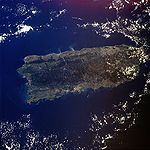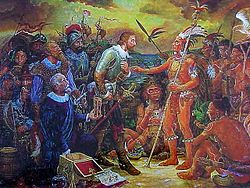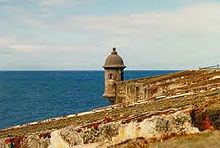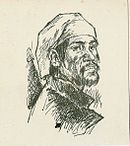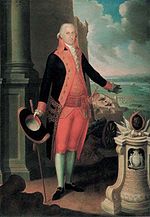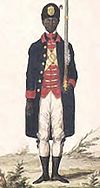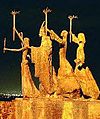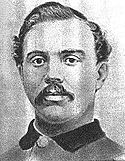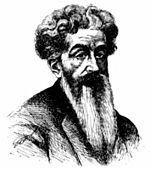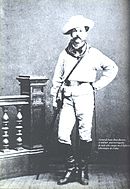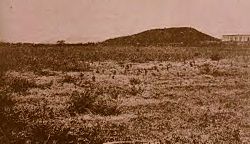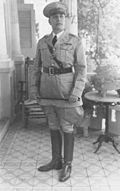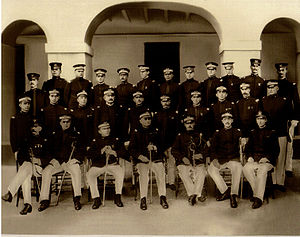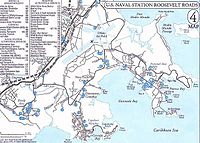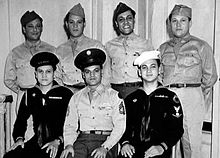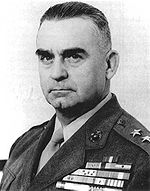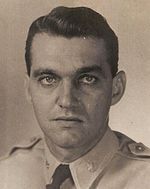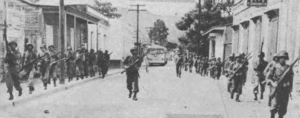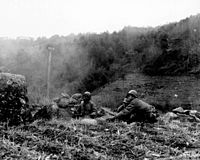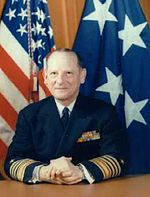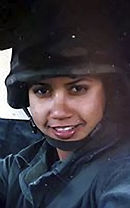- Military history of Puerto Rico
-
The recorded military history of Puerto Rico encompasses the period from the 16th century, when Spanish conquistadores battled native Tainos in the rebellion of 1511, to the present employment of Puerto Ricans in the United States Armed Forces in the military campaigns in Afghanistan and Iraq.
Puerto Rico was part of the Spanish Empire for four centuries, when the Puerto Ricans defended themselves against invasions from the British, French, and Dutch. They fought alongside General Bernardo de Gálvez during the American Revolutionary War in the battles of Baton Rouge, Mobile, Pensacola and St. Louis. During the mid-19th century, Puerto Ricans residing in the United States fought in the American Civil War.[1]
The quest for Latin American independence from Spain spread to Puerto Rico, in the short lived revolution known as El Grito de Lares and culminating with the Intentona de Yauco. The island was invaded by the United States during the Spanish-American War. After the war ended, Spain officially ceded the island to the United States under the terms established in the Treaty of Paris of 1898. Puerto Rico became a United States territory and the "Porto Rico Regiment" (Puerto Rico's name was changed to Porto Rico) was established on the island.
Upon the outbreak of World War I, the U.S. Congress approved the Jones-Shafroth Act, which made Puerto Ricans United States citizens and eligible for the military draft. As citizens of the United States, Puerto Ricans have participated in every major United States military engagement from World War I onward. During World War II, Puerto Ricans participated in the Pacific and Atlantic theatres, not only as combatants, but also as commanders. It was during this conflict that Puerto Rican nurses were allowed to participate as members of the WAAC's. The members of Puerto Rico's 65th Infantry Regiment distinguished themselves in combat during the Korean War and during the Vietnam War four Puerto Ricans were awarded the Medal of Honor, the highest military honor in the United States. Presently Puerto Ricans continue to serve in the military of the United States. The following is brief history of the military events in which Puerto Ricans have participated.
Taíno rebellion of 1511
Christopher Columbus arrived in the island of Puerto Rico on November 19, 1493, during his second voyage to the so-called "New World". The island was inhabited by the Arawak group of indigenous peoples known as Tainos, who called the island "Borikén" or "Borinquen". Columbus named the island San Juan Bautista in honor of Saint John the Baptist. The main port was named Puerto Rico (Rich Port) (eventually the island was renamed Puerto Rico and the port which was to evolve into the capital of the island was renamed San Juan). The conquistador Juan Ponce de León accompanied Columbus on this trip.[2]
When Ponce de León arrived in Puerto Rico, he was well received by the Cacique (Tribal chief) Agüeybaná (The Great Sun), chieftain of the island Taino tribes. Besides the conquistadors, some of the first colonists were farmers and miners in search of gold. In 1508, Ponce de León became the first appointed governor of Puerto Rico, founding the first settlement of Caparra between the modern-day cities of Bayamón and San Juan. After being named Governor, de León and the conquistadors forced the Tainos to work in the mines and to build fortifications; many Tainos died as a result of cruel treatment during their labor. In 1510, upon Agüeybaná's death, his nephew Güeybaná, better known as Agüeybaná II (The Brave), and a group of Tainos led Diego Salcedo, a Spaniard, to a river and drowned him, proving to his people that the white men were not gods. Upon realizing this, Agüeybaná II led his people in the Taino rebellion of 1511, the first rebellion in the island against the better armed Spanish forces. Guarionex, cacique of Utuado, attacked the village of Sotomayor (present day Aguada) and killed eighty of its inhabitants.[3] Cacique Guarionex died during the attack which was considered a Taino victory.[4]
After the Taino victory the colonists formed a citizens' militia to defend themselves against the attacks. Juan Ponce de León and one of his top commanders, Diego de Salazar led the Spaniards in a series of offensives which included a massacre of the Taino forces in the domain of Agüeybaná II. The Spanish offensive culminated in the Battle of Yagüecas against Cacique Mabodomoca.[5] Agüeybaná II was shot and killed, ending the first recorded military action in Puerto Rico.[6] After the failed rebellion, the Tainos were forced to give up their customs and traditions by order of a Royal decree, approved by King Ferdinand II, which required that they adopt and practice the values, religion and language of their conquerors.[4]
Europeans fight over Puerto Rico
16th Century
Puerto Rico was considered the "Key to the Antilles" by the Spanish because of its location as a way station and port for Spanish vessels. In 1540, with revenue from Mexican mines, the Spanish settlers began the construction of Fort San Felipe del Morro ("the promontory") in San Juan. With the completion of the initial phase of the construction in 1589 El Morro became the island's main military fortification, guarded by professional soldiers. The rest of Puerto Rico, which had been reorganized in 1580 as a captaincy general, had to rely on only a handful of soldiers and the local volunteer militia to defend the island against militant and pirate attacks.
The main enemies of Spain at the time were the British and the Dutch. They, however were not the only enemies that Spain faced in the Caribbean during this period. On October 11, 1528, the French sacked and burned the settlement of San Germán during an attempt to capture the island, destroying many of the island's first settlements—including Guánica, Sotomayor, Daguao and Loiza—before the local militia forced them to retreat. The only settlement that remained was San Juan.[7]
In 1585, war broke out between England and Spain. The Anglo-Spanish War was not limited to Europe—extending to Spanish and English territories in the Americas. On November 22, 1595, Sir Francis Drake, the vice-admiral in command of the Royal Navy that overcame the Spanish Armada, and Sir John Hawkins attempted an invasion of the island with 26 vessels. Unable to take the island, Drake set San Juan on fire. In 1596, Drake died of dysentery after another unsuccessful attack on San Juan.[8] On June 15, 1598, the British fleet, led by George Clifford, landed in Santurce and held the island for several months. He was forced to abandon the island upon an outbreak of bacillary dysentery among his troops. In 1599, 400 additional soldiers and 46 cannons were sent to the island along with a new governor, Alonso de Mercado, to rebuild the city.[9]
17th century
The Netherlands was a world military and commercial power by 1625, competing in the Caribbean with the British. The Dutch wanted to establish a military stronghold in the area, and dispatched Captain Boudewijn Hendricksz (also Boudoyno Henrico or Balduino Enrico) to capture Puerto Rico. On September 24, 1625, Enrico arrived at the coast of San Juan with 17 ships and 2,000 men. Enrico sent a message to the governor of Puerto Rico, Juan de Haros, ordering him to surrender the island. De Haros refused, he was an experienced military man and expected an attack in the section known as Boqueron. He therefore had that area fortified. However, the Dutch took another route and landed in La Puntilla.[7]
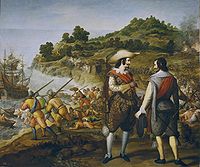 Seventeenth-century Spanish painting commemorating Enrico's defeat at San Juan de Puerto Rico; by Eugenio Caxés, Museo del Prado
Seventeenth-century Spanish painting commemorating Enrico's defeat at San Juan de Puerto Rico; by Eugenio Caxés, Museo del Prado
De Haro realized that an invasion was inevitable and ordered Captain Juan de Amezquita plus 300 men to defend the island from El Morro Castle and then had the city of San Juan evacuated. He also had former governor Juan de Vargas organize an armed resistance in the interior of the island. On September 25 Enrico attacked San Juan, besieging El Morro Castle and La Fortaleza (the Governor's Mansion). He invaded the capital city and set up his headquarters in La Fortaleza. The Dutch were counterattacked by the civilian militia on land and by the cannons of the Spanish troops in El Morro Castle. The land battle left 60 Dutch soldiers dead and Enrico with a sword wound to his neck which he received from the hands of Amezquita.[10] The Dutch ships at sea were boarded by Puerto Ricans who defeated those aboard. After a long battle, the Spanish soldiers and volunteers of the city's militia were able to defend the city from the attack and save the island from an invasion. On October 21, Enrico set La Fortaleza and the city ablaze. Captains Amezquita and Andre Botello decided to put a stop to the destruction and led 200 men in an attack against the enemy's front and rear guard. They drove Enrico and his men from their trenches and into the ocean in their haste to reach their ships.[11][12] Enrico upon his retreat would leave behind him one of his largest ships, stranded, and over 400 dead.[11] He then tried to invade the island by attacking the town of Aguada. He was again defeated by the local militia and abandoned the idea of invading Puerto Rico.[7][12]
While Spain and Britain were in a power struggle in the New World, Puerto Rican privateering of British ships was encouraged by the Spanish Crown. Captain Miguel Henriquez and Captain Roberto Cofresi (in the 19th century) were two of the most famous. In the first half of the 18th century, Henriquez, a shoemaker by occupation, decided to try his luck as a privateer. He showed great valor in intercepting British merchant ships and other ships dedicated to contraband that were infesting the seas of Puerto Rico and the Atlantic Ocean in general. He was so successful that his fleet was said to amount to 300 ships of various sizes with close to 1,500 sailors, he owned 300 slaves and his fortune, at the time, was among he largest in the Americas. Henriquez organized an expeditionary force which fought and defeated the British in the island of Vieques. He was received as a national hero when he returned the island of Vieques to the Spanish Empire and to the governorship of Puerto Rico. In recognition of his service, the Spanish Crown awarded Henriquez the Medalla de Oro de la Real Efigie (The Gold Medal of the Royal Effigy), named him "Captain of the Seas and War", and gave him a letter of marque and reprisal thus granting him the privileges of privateer.[13]
18th Century
Armed conflicts with the British
The British continued their attacks against Spanish colonies in the Caribbean, taking minor islands including Vieques east of Puerto Rico. On August 5, 1702, the city of Arecibo, on Puerto Rico's northern coast, was invaded by the British. Armed only with spears and machetes, under the command of Captain Antonio de los Reyes Correa, 30 militia members defended the city from the British, who were armed with muskets and swords. The British were defeated, suffering 22 losses on land and 8 at sea. Reyes Correa was declared a national hero and was awarded the Medalla de Oro de la Real Efigie ("Gold Medal of the Royal Image") and the title of "Captain of Infantry" by King Philip V.[14]
Native-born Puerto Rican (criollos) had petitioned the Spanish Crown to serve in the regular Spanish army, resulting in the 1741 organization of the Regimiento Fijo de Puerto Rico. The Fijo served in the defense of Puerto Rico and other Spanish overseas possessions, performing in battles in Santo Domingo, other islands in the Caribbean, and South America, most notably in Venezuela. However, Puerto Rican complaints that the Fijo was being used to suppress the revolution in Venezuela caused the Crown to bring the Fijo home and in 1815 it was mustered out of service.[15]
In 1765, the Spanish Crown sent Field Marshal Alejandro O'Reilly to Puerto Rico to form an organized militia. O'Reilly, known as the "Father of the Puerto Rican Militia", oversaw training to bring fame and glory to the militia in future military engagements, nicknaming the civilian militia the "Disciplined Militia." O'Reilly was later appointed governor of colonial Louisiana in 1769 and became known as "Bloody O'Reilly."[16][17]
During the American Revolutionary War, Spain lent the rebelling colonists the use of its ports in Puerto Rico, through which flowed financial aid and arms for their cause. An incident occurred in the coast of Mayagüez, in 1777, between two Continental Navy ships, the Eudawook and the Henry, and a Royal Navy warship, HMS Glasgow. Both American ships were chased by the larger and more powerful Glasgow. The American colonial ships were close to the coast of Mayagüez; members of the Puerto Rican militia of that town, realizing that something was wrong, signaled for the ships to dock at the town's bay. After the ships docked, the crews of both ships got off and some Mayagüezanos boarded and raised the Spanish flag on both ships. The commander of the Glasgow became aware of the situation and asked the island's governor, Jose Dufresne to turn over the ships. Dufresne refused and ordered the British warship out of the Puerto Rican dock.[18]
The American Revolutionary War
The governor of Louisiana, Bernardo de Gálvez, was named Field Marshal of the Spanish colonial army in North America. In 1779, Galvez and his troops, composed of Puerto Ricans and people from other Spanish colonies, distracted the British from the revolution by capturing Pensacola, the capital of the British colony of West Florida and the cities of Baton Rouge, St. Louis and Mobile. The Puerto Rican troops, under the leadership of Brigadier General Ramón de Castro,[19] helped defeat the British and Indian army of 2,500 soldiers and British warships in Pensacola.[20] Galvez and his multinational army also provided the Continental Army with guns, cloth, gunpowder and medicine shipped from Cuba up the Mississippi River. General Ramón de Castro, who was Galvez's Aide-de-camp in the Mobile and Pensacola campaigns, became the appointed governor of Puerto Rico in 1795.[21][22]
Sir Ralph Abercromby attacks Puerto Rico
On February 17, 1797, the governor of Puerto Rico Brigadier General Ramón de Castro, received news that Great Britain had invaded the island of Trinidad. Believing that Puerto Rico would be the next British objective he decided to put the local militia on alert and to prepare the island's forts against any military action. On April 17, 1797, British ships under the command of Sir Ralph Abercromby approached the coastal town of Loíza, to the east of San Juan. On April 18, British soldiers and German mercenaries ("Hessians") landed on Loíza's beach. Under the command of de Castro, British ships were shot at by artillery from both El Morro and the San Gerónimo fortresses but were beyond reach. After the invaders disembarked practically all fighting was land based with many skirmishes, field artillery and mortar fire exchanges between the San Gerónimo and San Antonio Bridge fortress and British emplacements in Condado to the East and El Olimpo hill in Miramar to the South. The British tried to take the San Antonio, a key passage to the San Juan islet, and repeatedly bombarded the nearby San Gerónimo to the tune of nearly one thousand shells and almost demolishing it. At the Martín Peña Bridge, they were met by the likes of Sergeants Jose and Francisco Diaz and Colonel Rafael Conti who together with Lieutenant Lucas de Fuentes attacked the enemy with two cannons. After fiercely fighting by the Spanish forces and local militia, they were defeated in all attempts to advance into San Juan. The invasion failed because Puerto Rican volunteers and Spanish troops fought back and defended the island in a manner described by a British lieutenant as of “astonishing bravery".
"La Rogativa" folklore
The defense of San Juan served as the base for the legend of "La Rogativa". According to the popular Puerto Rican legend, on the night of April 30, 1797, the townswomen, led by a bishop, formed a rogativa (prayer procession) and marched throughout the streets of the city singing hymns and carrying torches while at the same time praying for the deliverance of the city. Outside the walls, the invaders mistook the torch-lit movement for the arrival of Spanish reinforcements. When morning came, the enemy was gone from the island and the city was saved from a possible invasion. Four statues, sculptured by Lindsay Daen in the Plazuela de la Rogativa (Rogativa Plaza) in Old San Juan, pay tribute to the bishop and townswomen who participated in La Rogativa.[23][24]
Attack of Aguadilla
The British also attacked Aguadilla and Punta Salinas. They were defeated by Colonel Conti and the members of the militia in Aguadilla, and the British troops that had landed on the island were taken prisoner. The British retreated on April 30 to their ships and on May 2 set sail northward. Because of the defeat given to the British forces, governor Ramon de Castro petitioned Spanish King Charles IV for recognition for the victors; he was promoted to Field Marshal and several others were promoted and given pay raises.[7][25] The British persisted in invading Puerto Rico, after Abercromby's defeat, with unsuccessful skirmishes on the coastal towns of Aguadilla (December 1797), Ponce, Cabo Rojo, and Mayagüez. This continued to occur until 1802 when the war finally came to an end.[26]
19th Century
France had threatened to invade the Spanish Colony of Santo Domingo. In 1808, the Spanish Crown sent their Navy, under the command of Puerto Rican Captain Ramon Power y Giralt, to prevent the invasion of Santo Domingo by the French by enforcing a blockade. Col. Rafael Conti organized a military expedition with the intention of defending the Dominican Republic. They were successful and were proclaimed as heroes by the Spanish Government.[27]
American Civil War
During the 1800s, commerce existed between the ports of the eastern coast of the United States and Puerto Rico. Ship records show that many Puerto Ricans traveled on ships that sailed from and to U.S. and Puerto Rico. Many of them settled in places such as New York, Connecticut and Massachusetts. Upon the outbreak of the American Civil War, many Puerto Ricans joined the ranks of military armed forces, however since Puerto Ricans were Spanish subjects they were inscribed as Spaniards. The 1860 census of New Haven, Connecticut, shows there were 10 Puerto Ricans living there. Among of them was Augusto Rodriguez who joined the 15th Connecticut Regiment (a.k.a. Lyon Regiment) in 1862. During the Civil War, Rodriguez, who reached the rank of Lieutenant, served in the defenses of Washington, D.C.. He also led his men in the Battles of Fredericksburg and Wyse Fork. The regiment was mustered out on June 27, 1865 and he was discharged in New Haven on July 12, 1865.[1]
Revolt against Spain
South America
 General Antonio Valero de Bernabe, the "Liberator from Puerto Rico"
General Antonio Valero de Bernabe, the "Liberator from Puerto Rico"
In 1822, there was an attempt, known as the Ducoudray Holstein Expedition, conceived, carefully planned and organized General Henri La Fayette Villaume Ducoudray Holstein to invade Puerto Rico and declare it a republic.[28]
This invasion was different from all its precursors since none before had intended to make Puerto Rico an independent nation, and use the Taino name "Boricua" as the official name of the republic, it was also intended more as a mercantile venture than a patriotic endeavor. It was the first time an invasion intended to make the city of Mayagüez the capital of the island.[28] However, plans of the invasion were soon disclosed to the Spanish authorities and the plot never materialized.
United Provinces of New Granada
In the early 19th century the Spanish colonies, in what is known as the Latin American wars of independence, began to revolt against Spanish rule. Antonio Valero de Bernabe was a Puerto Rican military leader known in Latin America as the "Liberator from Puerto Rico". Valero was a recent graduate of the Spanish Military Academy when Napoleon Bonaparte convinced King Charles IV of Spain to permit him to pass through Spanish soil with the sole purpose of attacking Portugal. When Napoleon refused to leave, the Spanish government declared war. Valero joined the Spanish Army and helped defeat Napoleon's army at the Siege of Saragossa. Valero became a hero; he was promoted to the rank of colonel and was awarded many decorations.[29]
When Ferdinand VII assumed the throne of Spain in 1813, Valero became critical of the new king's policies towards the Spanish colonies in Latin America. He developed a keen hatred of the monarchy, resigned his commission in the army, and headed for Mexico. There he joined the insurgent army headed by Agustín de Iturbide, in which Valero was named chief of staff. He fought for and helped achieve Mexico's independence from Spain. After the Mexican victory, Iturbide proclaimed himself Emperor of Mexico. Since Valero had developed anti-monarchist feelings following his experiences in Spain, he revolted against Iturbide. His revolt failed and he attempted to escape from Mexico by way of sea.[29]
Valero was captured by a Spanish pirate, who turned him over to the Spanish authorities in Cuba. Valero was imprisoned but managed to escape with the help of a group of men that identified with Simón Bolívar's ideals. Upon learning of Bolívar's dream of creating a unified Latin America, including Puerto Rico and Cuba, Valero decided to join him. Valero stopped in St. Thomas, where he established contacts with the Puerto Rican independence movement.
He then traveled to Venezuela, where he was met by General Francisco de Paula Santander.[29] He next joined Bolívar and fought alongside "The Liberator" against Spain, gaining his confidence and admiration. Valero was named Military Chief of the Department of Panama, Governor of Puerto Cabello, Chief of Staff of Colombia, Minister of War and Maritime of Venezuela, and in 1849 was promoted to the rank of Brigadier General.[30]
The meetings of the Puerto Rican Independence movement which met in St. Thomas were discovered by the Spanish authorities and the members of the movement were either imprisoned or exiled. In a letter dated October 1, 1824, which Venezuelan rebel leader José María Rojas sent to María de las Mercedes Barbudo, Rojas stated that the Venezuelan rebels had lost their principal contact with the Puerto Rican Independence movement in the Danish island of Saint Thomas and therefore the secret communication which existed between the Venezuelan rebels and the leaders of the Puerto Rican independence movements was in danger of being discovered.[31]
Mercedes Barbudo, also known as the “first Puerto Rican female freedom fighter”, was a businesswoman who became a follower of the independence ideal for Puerto Rico upon learning that Bolivar dreamed of eventually engendering an American Revolution-style federation, that would be known as the United Provinces of New Granada, between all the newly independent republics, with a government ideally set-up solely to recognize and uphold individual rights. She was involved with the Puerto Rican Independence Movement which had ties with the Venezuelan rebels led by Simon Bolivar and who were against Spanish colonial rule in Puerto Rico.[32][32]
Unknown to Mercedes Barbudo, the Spanish authorities in Puerto Rico under Governor Miguel de la Torre, were suspicious of the correspondence between her and the rebel factions of Venezuela. Secret agents of the Spanish Government had retained some of her mail and delivered it to Governor de la Torre. He ordered an investigation and had her mail confiscated. The Government believed that the correspondence served as propaganda of the Bolivian ideals and that it would also serve to motivate Puerto Ricans to seek their independence.[33] Governor Miguel de la Torre ordered her arrest on the charge that she planned to overthrow the Spanish Government in Puerto Rico. Since Puerto Rico did not have a women’s prison she was held without bail at the Castillo San Cristóbal. Among the evidence which the Spanish authorities presented against her was Rojas letter. She was exiled to Cuba where she was able to escape and make her way to Venezuela where she spent her final days.[33]
Puerto Rico
The Spanish government had received many complaints from the nations whose ships were attacked by Puerto Rican pirate Captain Roberto Cofresi. Cofresi and his men had attacked eight ships, amongst them an American ship. The Spanish government, which routinely encouraged piracy against other nations, was pressured and felt obliged to pursue and capture the famous pirate. In 1824, Captain John Slout of the U.S. Naval Forces and his schooner "U.S. "Grampus" engaged Cofresi in a fierce battle. The pirate Cofresi was captured, along with eleven of his crew members, and turned over to the Spanish Government. He was imprisoned in El Castillo del Morro in San Juan. Cofresi was judged by a Spanish Council of War, found guilty, and executed by firing squad on March 29, 1825.[34]
On April 13, 1855, a mutiny broke out among the artillerymen at Fort San Cristóbal. They were protesting an extended two years of military service imposed by the island's Spanish governor, Garcia Cambia. The mutineers pointed their cannons towards San Juan, creating a state of panic among the population. Upon their surrender, the governor had the eight men arrested and sentenced to death by firing squad.[35]
Grito de Lares
Many Spanish colonies had gained their independence by the mid-1850s. In Puerto Rico, there were two groups: the loyalists, who were loyal to Spain, and the independentistas, who advocated independence. In 1866, Dr. Ramón Emeterio Betances, Segundo Ruiz Belvis, and other independence advocates met in New York City where they formed the Revolutionary Committee of Puerto Rico. An outcome of this venture was a plan to send an armed expedition from the Dominican Republic to invade the island. Several revolutionary cells were formed in the western towns and cities of Puerto Rico. Two of the most important cells were at Mayagüez, led by Mathias Brugman and code named "Capa Prieto" and at Lares, code-named "Centro Bravo" and headed by Manuel Rojas. "Centro Bravo" was the main center of operations and was located in the Rojas plantation of El Triunfo. Manuel Rojas was named "Commander of the Liberation Army" by Betances. Mariana Bracetti (sister-in-law of Manuel) was named "Leader of the Lares Revolutionary Council." Upon the request of Betances, Bracetti knitted the first flag of Puerto Rico also known as the revolutionary Flag of Lares (Bandera de Lares).[36]
The Spanish authorities discovered the plot and were able to confiscate Betances's armed ship before it arrived in Puerto Rico. The Mayor of the town of Camuy, Manuel González (leader of that town's revolutionary cell), was arrested and charged with treason. He learned that the Spanish Army was aware of the independence plot, and escaped to warn Manuel Rojas. Alerted, the revolutionists decided to start the revolution as soon as possible, and set the date for September 28, 1868. Mathias Brugman and his men joined with Manuel Rojas's men and with about 800 men and women, marched on and took the town of Lares. This was to be known as "El Grito de Lares." The revolutionists entered the town's church and placed Mariana Bracetti's revolutionary flag on the High Altar as a sign that the revolution had begun. They declared Puerto Rico to be the "Republic of Puerto Rico" and named Francisco Ramirez its President. Manuel and his poorly armed followers proceeded to march on to the town of San Sebastián, armed only with clubs and machetes. The Spanish Army had been forewarned, and awaited with superior fire power. The revolutionists were met with deadly fire. The revolt failed, many revolutionists were killed, and at least 475, including Manuel Rojas and Mariana Bracetti, were imprisoned in the jail of Arecibo and sentenced to death.[37][38]
Others fled and went into hiding. Mathias Brugman was hiding in a local farm where he was betrayed by a farmer named Francisco Quiñones; he was captured and executed on the spot. In 1869, fearing another revolt, the Spanish Crown disbanded the Puerto Rican Militia, which had been composed almost entirely of native-born Puerto Ricans, and also the Compañia de Artilleros Morenos de Cangrejos, a separate company of black Puerto Ricans. They then organized the Volunteer Institute, composed entirely of Spaniards and their sons.[39]
Intentona de Yauco
On March 26, 1897, there was a second and last major attempt to overthrow the Spanish government. Antonio Mattei Lluveras and Fidel Velez, local leaders of the independence movement of the town of Yauco, organized a coup, which became known as the "Intentona de Yauco". It was during this uprising that the current version of the Puerto Rican flag was first unfurled on Puerto Rican soil. The local conservative political factions, which believed that such an attempt would be a threat to their struggle for autonomy, opposed such an action. Rumors of the planned event spread to the local Spanish authorities who acted swiftly and put an end to the uprising.[40]
Cuba
In 1869, the incoming governor of Puerto Rico, Jose Laureano Sanz, in an effort to ease tensions in the island, dictated a general amnesty and released all who were involved with the Grito de Lares revolt from prison. Both Mariana Bracetti and Manuel Rojas were released. Bracetti lived her lst years in the town of Añasco, while Rojas was deported to Venezuela.[41] Many of the former prisoners joined the Cuban Liberation Army and fought against Spain. Among the many Puerto Ricans who volunteered to fight for Cuba's independence were Juan Ríus Rivera, Francisco Gonzalo Marín, also known as "Pachin Marín" and José Semidei Rodríguez.
Juan Ríus Rivera as a young man met and befriended Betances, and was joined the pro-independence movement in the island. He became a member of the Mayagüez revolutionary cell "Capá Prieto" under the command of Brugman. Ríus, did not participated directly in the revolt because at the time he was studying law in Spain, however he was an avid reader about information pertaining to the Antilles and learned about the failed revolt. He interrupted his studies and traveled to the United States where he went to the Cuba Revolutionary "Junta" and offered his services. He joined the Cuban Liberation Army and was given the rank of General. He fought alongside Gen. Máximo Gómez in Cuba's Ten Years' War. He later fought alongside Gen. Antonio Maceo Grajales and upon Maceo's death was named Commander-in-Chief of the Cuban Liberation Army. After Cuba gained its independence, Gen. Juan Ríus Rivera became an active political figure in the new nation.[42]
Francisco Gonzalo Marín was a renowned poet and journalist in Puerto Rico who joined the Cuban Liberation Army upon learning of the death of his brother Wecenlao in the battlefields of Cuba. Marin, who was given the rank of Lieutenant, befriended and fought alongside José Martí. In November 1897 Lt. Marin died from the wounds he received in a skirmish against the Spanish Army.[43]
José Semidei Rodríguez from Yauco, Puerto Rico, fought in various battles in the Cuban War of Independence (1895–1898). After Cuba gained its independence he joined the Cuban National Army with the rank of Brigadier General. Semidei Rodríguez continued to serve in that country as a diplomat upon his retirement from the military.[40]
Spanish-American War
In 1890, Captain Alfred Thayler Mahan, a member of the Navy War Board and leading U.S. strategic thinker, wrote a book titled "The Influence of Sea Power upon History" in which he argued for the creation of a large and powerful navy modeled after the British Royal Navy. Part of his strategy called for the acquisition of colonies in the Caribbean Sea which would serve as coaling and naval stations and which would serve as strategical points of defense upon the construction of a canal in the Isthmus.[44]
This was not new, since William H. Stewart, the former Secretary of State under the administrations of various presidents, among them Abraham Lincoln and Ulysses Grant, had stressed that a canal be built either in Honduras, Nicaragua or Panama and that the United States annex the Dominican Republic and purchase Puerto Rico and Cuba. The idea of annexing the Dominican Republic failed to receive the approval of the U.S. Senate and Spain did not accept the 160 million dollars which the U.S. offered for Puerto Rico and Cuba.[44]
Captain Mahan made the following statement to the to the War Department:
"Having therefore no foreign establishments either colonial or military, the ships of war of the United States, in war will be like land birds, unable to fly far from their own shores. To provide resting places for them where they can coal and repair. would be one of the first duties of a government proposing to itself the development of the power of the nation at sea"[45]
Since 1894, the Naval War College had been formulating plans for war with Spain. By 1896, the Office of Naval Intelligence had prepared a plan which including military operations in Puerto Rican waters. Not only was Puerto Rico considered a valuable as a naval station, Puerto Rico and Cuba were also abundant in valuable commercial commodity which the United States lacked, that commodity was sugar.[46]
The United States declared war on Spain in 1898 following the sinking of the battleship "Maine" in Havana harbor, Cuba. One of the United States's principal objectives in the Spanish-American War was to take control of Spanish possessions Puerto Rico and Cuba in the Atlantic, and the Philippines and Guam in the Pacific.
The Spanish Crown sent the 1st, 2nd and 3rd Puerto Rican Provisional Battalions to defend Cuba against the American invaders. The 1st Puerto Rican Provisional Battalion, composed of the Talavera Cavalry and Krupp artillery, was sent to Santiago de Cuba where they battled the American forces in the Battle of San Juan Hill. After the battle, the Puerto Rican Battalion suffered a total of 70% casualties which included their dead, wounded, MIA's and prisoners.[47]
The invasion of Puerto Rico by the American military forces was known as the Puerto Rican Campaign. On May 10, 1898, Spanish forces, under the command of Capt. Angel Rivero Mendez in the fortress of San Cristobal in San Juan, exchanged fire with the USS Yale, and on May 12 a fleet of 12 American ships bombarded San Juan.[48] On June 25, the USS Yosemite arrived in San Juan and blockaded the port. On July 25, General Nelson A. Miles entered the southern town of Guánica with 3,300 troops and faced a minor skirmish in their landing.
One of the most notable battles during the Puerto Rico Campaign occurred between the Spanish forces and Puerto Rican volunteers, led by Captain Salvador Meca and Lieutenant Colonel Francisco Puig against the American forces led by Brigadier General George A. Garretson on July 26, 1898. The Spanish forces engaged the 6th Massachusetts in a firefight in what became known as the Battle of Yauco. Puig and his forces suffered 2 officers and 3 soldiers wounded and 2 soldiers dead. The Spanish forces were ordered to retreat.[49]
The Puerto Rican Campaign was short compared to the other campaigns because the Puerto Ricans who resided in the southern and western towns and villages resented Spanish rule and tended to view the Americans as their liberators, thereby making the invasion much easier and because, as stated before, the 1st, 2nd and 3rd Puerto Rican Provisional Battalions where in Cuba defending that island. However, the Americans met resistance from the Spanish forces and Puerto Rican Volunteers and were engaged in the following battles: Battle of Fajardo, Battle of Guayama, Battle of the Guamani River Bridge, Battle of Coamo, Battle of Silva Heights and Battle of Asomante.[49] On August 13, 1898, the Spanish-American War ended and the Spanish surrendered without other major incidents. Some Puerto Rican leaders such as José de Diego and Eugenio María de Hostos expected the United States to grant the island its independence.[50][51] Believing that Puerto Rico would gain its independence, a group of men staged an uprising in Ciales which became known as "El Levantamiento de Ciales" or the "Ciales Uprising of 1898" and proclaimed Puerto Rico to be a republic. The Spanish authorities who were unaware that the cease fire had been signed brutally suppressed the uprising[52] The total casualties of the Puerto Rican Campaign were 450 dead or wounded Spanish and Puerto Ricans, and 4 dead and 39 wounded Americans.[53]
Upon the signing of the Treaty of Paris on December 10, Puerto Rico became a territory of the United States. The Spanish troops had already left by October 18, and the United States named General Nelson A. Miles military governor of the island. On July 1, 1899, "The Porto Rico Regiment of Infantry, United States Army" was created, and approved by the U.S. Congress on May 27, 1908. The regiment was a segregated, all-volunteer unit made up of 1,969 Puerto Ricans.[53]
Puerto Rican commandor in the Philippines
In 1897, before the onset of fighting in Puerto Rico, Juan Alonso Zayas, born in San Juan, was a Second Lieutenant in the Spanish Army when he received orders to head for the Philippines to take command of the 2nd Expeditionary Battalion stationed in Baler. He arrived in Manila, the capital, in May 1897. There he took a vessel and headed for Baler, on the island of Luzon. The distance between Manila and Baler is 62 miles (100 km); if traveled through the jungles and badly-built roads, the actual distance was 144 miles (230 km). At that time a system of communication between Manila and Baler was almost non-existent. The only way Baler received news from Manila was by way of vessels. The Spanish colonial government was under constant attack from local Filipino groups who wanted independence. Zayas's mission was to fortify Baler against any possible attack. Among his plans for the defense of Baler was to convert the local church of San Luis de Tolosa into a fort.[54]
The independence advocates, under the leadership of Colonel Calixto Vilacorte, were called "insurgents" (Tagalos) by the Spanish crown. On June 28, 1898, they demanded the surrender of the Spanish army. The Spanish governor of the region, Enrique de las Morena y Fossi, refused; the Filipinos immediately attacked Baler in a battle that was to last for seven months. Despite being outnumbered and suffering hunger and disease, the battalion did not capitulate. In the meantime, Zayas and the rest of the battalion were totally unaware of the Spanish-American War that was going on. On August 1898, the hostilities between the United States and Spain came to an end. The Philippines became a U.S. possession under the accordance of the Treaty of Paris. In May 1899, the Battalion at Baler found out about the Spanish-American War and its aftermath. They had been unaware that they had been fighting for a possession which was no longer theirs to fight for. On June 2, 1899 the Battalion's commander, Lieutenant Martín Cerezo surrendered to the Tagalos only after some conditions were met. Among the conditions were the following:
- 1. That the Spaniards not be treated as prisoners of war and
- 2. that they would not be harmed in their quest of reaching a Spanish ship which would take them back to Spain.
The 32 survivors of Zayas Battalion were sent to Manila, where they boarded a ship for Spain. In Spain, they were given a hero's welcome and became known as los Ultimos de Baler—"the Last of Baler."[54]
Porto Rico Provisional Regiment of Infantry
On March 2, 1898, Congress authorized the creation of the first body of native troops in Puerto Rico. On June 30, 1901, the "Porto Rico Provisional Regiment of Infantry came into being. An Act of Congress, approved on May 27, 1908, reorganized the regiment as part of the "regular" Army. Since the native Puerto Rican officers where Puerto Rican citizens and not citizens of the United States, they were required to undergo a new physical examination to determine their fitness for commissions in the Regular Army and to take an oath of U.S. citizenship with their new officers oath.[40]
Puerto Rican National Guard
In 1906, a group of Puerto Ricans met with the appointed Governor Winthrop, and suggested the organization of a Puerto Rican National Guard. The petition failed because the U.S. Constitution prohibits the formation of any armed force within the United States and its territories without the authorization of Congress.[55]
On June 19, 1915, Major General Luis R. Esteves of the U.S. Army became the first Puerto Rican to graduate from the United States Military Academy at West Point, New York. While he attended West Point, he tutored fellow classmate Dwight D. Eisenhower in Spanish; a second language was required in order to graduate. He was a Second Lieutenant in the 8th Infantry Brigade of the army under the command of John J. Pershing when he was sent to El Paso, Texas in the Pancho Villa Expedition. From El Paso, he was sent to the town of Polvo, where he was appointed mayor and judge by its citizens. Esteves helped organize the 23rd Battalion, which would be composed of Puerto Ricans and be stationed in Panama during World War I. He would also play a key role in the formation of the Puerto Rico National Guard.[56]
World Wars
World War I
Lieutenant Teofilo Marxuach was the officer of the day at El Morro Castle on March 21, 1915. The Odenwald, built in 1903 (not to be confused with the German World War II war ship which carried the same name), was an armed German supply ship which tried to force its way out of the San Juan Bay and deliver supplies to the German submarines waiting in the Atlantic Ocean. Lt. Marxuach gave the order to open fire on the ship from the walls of the fort. Sergeant Encarnacion Correa then manned a machine gun and fired warningf shots with little effect.[40] Marxuach fired a shot from a cannon located at the Santa Rosa battery of "El Morro" fort, in what is considered to be the first shot of World War I fired by the regular armed forces of the United States against any ship flying the colors of the Central Powers,[57] forcing the Odenwald to stop and to return to port where its supplies were confiscated. The shots ordered by Lt. Marxuach were the first fired by the United States in World War I. The Odenwald was confiscated by the United States and renamed SS Newport. It was assigned to the U.S. Shipping Board, where it served until 1924 when it was retired.[58]
As more countries became involved in what became known as World War I, the U.S. Congress approved the Jones-Shafroth Act, which granted Puerto Ricans United States citizenship.[59] As a result, many Puerto Ricans, with the exception of women, became eligible for the military draft. On May 3, 1917, the Regiment recruited 1,969 men. The 295th and 296 Infantry Regiments were created in Puerto Rico.[60] On November 1917, the first military draft (conscription) lottery in Puerto Rico was held in the island's capital, San Juan. The first draft number was picked by Diana Yaeger, the daughter of the U.S. appointed governor of Puerto Rico Arthur Yager. The number she picked was 1435 and it belonged to San Juan native Eustaquio Correa. Thus, Correa became the first Puerto Rican to be "drafted" into the Armed Forces of the United States.[61]
On May 17, 1917, the Porto Rico Regiment of Infantry was sent to guard the Panama Canal in defense of the Panama Canal Zone One of the Puerto Ricans who distinguished himself during World War I was Lieutenant Frederick Lois Riefkohl of the US Navy, who on August 2, 1917, became the first known Puerto Rican to be awarded the Navy Cross. The Navy Cross, which is the second highest medal after the Medal of Honor, that can be awarded by the U.S. Navy, was awarded to Lt. Riefkohl for his actions in an engagement with an enemy submarine. Lt. Riefkohl, who was also the first Puerto Rican to graduate from the United States Naval Academy, served as a Rear Admiral in World War II.[62]
By 1918, the Army realized that there was a shortage of physicians specializing in anesthesia, a low salary specialty required in the military operating rooms. Therefore, the Army reluctantly began hiring women physicians as civilian contract employees. The first Puerto Rican woman doctor to serve in the Army under contract was Dr. Dolores Piňero from San Juan. She was assigned to the San Juan base hospital where she worked as an anesthesiologist during the mornings and in the laboratory during the afternoons.[63]
In New York, many Puerto Ricans joined the 369th Infantry Regiment which was mostly composed of Afro-Americans. They were not allowed to fight alongside their white counterparts; however, they were permitted to fight as members of a French unit in French uniforms. They fought along the Western Front in France, and their reputation earned them the nickname of "the Harlem Hell Fighters" by the Germans. Among them was Rafael Hernández Marín, considered by many as Puerto Rico's greatest composer. The 369th was awarded French Croix de guerre for battlefield gallantry by the French President.
Marine aviation was fairly new, it came into existence on May 22, 1912, and the first major expansion of the Marine Corps' air component, of which Puerto Rico played a major rule, came with America's entrance into World War I. On January 6, 1914, First Lieutenant Bernard L. Smith established the Marine Section of the Navy Flying School in the island municipal Culebra.[64] As the number of Marine Aviators grew so did the avid desire to separate from Naval Aviation.[65] By doing so, the Marine Aviation was designated as separate from the United Staes Naval Aviation. The creation of a "Marine Corps Aviation Company in Puerto Rico consisted of 10 officers and 40 enlisted men.[66]
First Lieutenant Félix Rigau Carrera, from Sabana Grande, had received his pilot training in private pilot schools in Seattle, Washington and Minneapolis, Minnesota. He then traveled to New York City and joined the Marine Corps. After receiving additional aviation training he was commissioned a Second Lieutenant and assigned to the First Marine Air Squadron which deployed to France as the newly renamed 1st Marine Aviation Force in July 1918.[67] There Rigau Carrera and his unit provided bomber and fighter support to the Navy's Day Wing, Northern Bombing Group, thus Rigau Carrera became the first Hispanic fighter pilot in the Marines.[68][69]
The Porto Rico Regiment returned to Puerto Rico on March 1919 and was renamed the 65th Infantry Regiment under the Reorganization Act of June 4, 1920.[70] It is estimated that 18,000 Puerto Ricans from the Porto Rico Regiment served in the war and that 335 were wounded by the chemical gas experimentation which the United States conducted as part of its active chemical weapons program in Panama,[71] however neither the military nor the War Department of the United States kept statistics in regard to the total number of Puerto Ricans who served in the regular units of the Armed Forces (United States mainland forces), therefore, even though it is known that four Puerto Ricans died in combat, it is impossible to determine the exact number of Puerto Ricans who served and perished in World War I.
The need for a Puerto Rican National Guard unit became apparent to Major General Luis R. Esteves, who had served as instructor of Puerto Rican Officers for the Porto Rico Regiment of Infantry at Camp Las Casas in Puerto Rico. His request was met with the approval of the government and Puerto Rican Legislature. In 1919, the first regiment of the Puerto Rican National Guard was formed, and General Luis R. Esteves became the first official Commandant of the Puerto Rican National Guard.[72][73]
Second Nicaraguan Campaign (1926–1933)
After World War I, Puerto Ricans fought on foreign shores as members of the United States Marine Corps. Civil war broke out in Nicaragua during the first months of 1926, and upon the request of the Nicaraguan government, 3,000 U.S. Marines were sent ashore to establish a neutral zone for the protection of American citizens. The American intervention was also known as the Banana Wars. Both Captain Pedro del Valle and Private Rafel Toro from Puerto Rico, participated in the Second Nicaraguan Campaign.[74]
In 1926, Captain del Valle served with the Gendarmerie of Haiti for three years and during that time, he also became active in the war against Augusto Sandino in Nicaragua. In 1927, Lieutenant Jaime Sabater, from San Juan, Puerto Rico graduated from United States Naval Academy.[75]
Private Rafel Toro, from Humacao, Puerto Rico, was part of the U.S. Marine Corps occupation force in Nicaragua, serving with the Guardia Nacional de Nicaragua. On July 25, 1927, Private Toro was assigned to advance guard duty in Nueva Segovia. As he rode into town, he was attacked; returning fire, he was able to hold back the enemy until reinforcements arrived. He was mortally wounded in this action for which he was posthumously awarded the Navy Cross.[76]
Puerto Rico suffered greatly during the Great Depression of the 1930s, and many Puerto Ricans moved to the East Coast of the United States looking for jobs and a better way of life. On the island, the unemployment rate continued to rise and many Puerto Ricans who were unable to find a job looked to the Armed Forces of the United States as a source of employment. Not only were they paid better than at the few other available jobs, but they were also guaranteed three meals a day, clothing, and shelter.[77]
The Rif War (1920)
After the Spanish-American War, members of the Spanish forces and civilians who were loyal to the Spanish Crown were allowed to return to Spain. Those who returned to their motherland took with them their Puerto Rican spouses and children. Among those who were born in Puerto Rico and who would go on to serve in the Rif War as members of the Spanish mititary were General Manuel Goded Llopis and Captain Felix Arenas Gaspar. The Rif War is a rebellion against Spanish colonial rule took place in Spanish Morocco, a Spanish protectorate in 1919.[78] During the Rif War Captain Felix Arenas Gaspar, who was born in San Juan, distinguished himself in combat. He was posthumously awarded the Cruz Laureada de San Fernando "Laureate Cross of Saint Ferdinand" (Spain's version of the United States Medal of Honor) for his actions in the defense of his company.[79]
Spanish Civil War (1936–1939)
Before the United States entered World War II, Puerto Ricans were already fighting on European soil, not only in the Rif War, but also on both sides of the Spanish Civil War.
The Spanish Civil War was a major conflict in Spain that started after an attempted coup d'état committed by parts of the army, led by the Fascist General Francisco Franco, against the government of the Second Spanish Republic. Puerto Ricans fought on behalf of both of the factions involved, the "Nationalists" as members of the Spanish Army and the "Loyalists" (Republicans) as members of the Abraham Lincoln International Brigade.[80]
Among the Puerto Ricans who fought alongside General Franco on behalf of the Nationalists was General Manuel Goded Llopis (1882–1936), a high ranking officer in the Spanish Army. Llopis, who was born in San Juan, was named Chief of Staff of the Spanish Army of Africa, after his victories in the Rif War, took the Balearic Islands and by order of Franco, suppressed the rebellion of Asturias. Llopis was sent to lead the fight against the Anarchists in Catalonia, but his troops were outnumbered. He was captured and was sentenced to die by firing squad.[81][82]
Among the many Puerto Ricans who fought on behalf of the Second Spanish Republic as members of the Abraham Lincoln Brigade, was Lieutenant Carmelo Delgado Delgado (1913–1937), a leader of the Puerto Rican Nationalist Party from Guayama who upon the outbreak of the Spanish Civil War was in Spain in pursuit of his law degree. Delgado was an anti-fascist who believed that the Spanish Nationalists were traitors. He fought in the Battle of Madrid, but was captured and was sentenced to die by firing squad on April 29, 1937, he was amongst the first US citizens to die in that conflict.[83]
World War II
The Pearl Harbor of the Atlantic
In 1940, when Germany attacked Great Britain, the United States feared that if Germany controlled Great Britain, Mexico and the U.S. would be next. In the same year, President Franklin Delano Roosevelt ordered the construction of a naval base in the Atlantic similar to Pearl Harbor in Hawaii. The site was meant to provide anchorage, docking, repair facilities, fuel, and supplies for 60% of the Atlantic Fleet. The naval base, which was named U.S. Naval Station Roosevelt Roads’ became the largest naval installation in the world in land mass and was meant to be the Pearl Harbor of the Atlantic, however with the defeat of Germany, the United States concentrated all of their efforts to the war in the Pacific. In May 2003, after six decades of existence, the base was officially shut down by the U.S. Navy.[84][85]
In 1939, a survey was conducted of possible air base sites. It was determined that Punta Borinquen was the best site for a major air base. Later that year, Major Karl S. Axtater assumed command of what was to become "Borinquen Army Air Field" (Later renamed Ramey Air Force Base). The first squadron based at Borinquen Field was the 27th Bombardment Squadron, consisting of nine B-18A Bolo medium bombers. In 1940, the air echelon of the 25th Bombardment Group (14 B-18A aircraft and two A-17 aircraft) arrived at the base from Langley Field.[86]
During World War II, the following squadrons were assigned to the airfield:
- 27th Engineer Battalion (Combat), 9 Oct 1939 (formed at Fort Dupont, Delaware) - 20 Oct 1939 (arrives in Puerto Rico)
- Headquarters, 13th Composite Wing, 1 Nov 1940-6 Jan 1941; 1 May-25 Oct 1941
- Headquarters, 25th Bombardment Group, 1 Nov 1940-1 Nov 1942; 5 Oct 1943-24 Mar 1944
- 417th Bombardment Squadron, 21 Nov 1939-13 Apr 1942 (B-18 Bolo)
- 10th Bombardment Squadron, 1 Nov 1940-1 Nov 1942 (B-18 Bolo)
- 12th Bombardment Squadron, 1 Nov 1940-8 Nov 1941 (B-18 Bolo)
- 35th Bombardment Squadron, 31 Oct-11 Nov 1941 (B-18 Bolo)
- 44th Bombardment Squadron (40th Bombardment Group) 1 Apr 1941-16 Jun 1942 (B-18 Bolo)
- 20th Troop Carrier Squadron (Panama Air Depot) Jun 1942-Jul 1943 (C-47 Skytrain)
- 4th Tactical Reconnaissance Squadron (72d Reconnaissance Group) 27 Oct 1943-21 May 1945; 5 Oct 1945-20 Aug 1946
- 123d AAA Battalion - Fort Brooke
- 501st Military Police Battalion (Combat) - Fort Brooke
- Detached Enlisted Mens List - Fort Brooke
- 542d Military Police Battalion - Fort Brooke
- Battery D of the 123d Antiaircraft Artillery Gun Battalion - Cataño
- Battery B of the 253d Coast Artillery Regiment- Goat Island (Isla de Cabras)
- Battery B of the 123d AAA Battalion - Fort Brooke
- Battery C of the 253d Coast Artillery - Fort Brooke
- Battery C of the 123d AAA Battalion - far end of the harbor on the Rio Piedras
- 123d AAA Battalion Headquarters - Fort Buchanan
- Battery A of the 123d AAA Battalion - Fort Buchanan
- Antilles Air Command, 1 Mar-25 Aug 1946
- As: Antilles Air Division, 12 Jan 1948-22 Jan 1949
- 24th Composite Wing, 25 Aug 1946-28 Jun 1948
- Navy Patrol Plane Squadron VP-31 - Borinquen Field
Puerto Ricans in the military
In October 1940, the 295th and 296th Infantry Regiments of the Puerto Rican National Guard, founded by Major General Luis R. Esteves, were called into Federal Active Service and assigned to the Puerto Rican Department in accordance with the existing War Plan Orange.[87]
During World War II, it is estimated by the Department of Defense that 65,034 Puerto Ricans served in the U.S. military.[71][88] Soldiers from the island, serving in the 65th Infantry Regiment, participated in combat in the European Theater — in Germany and Central Europe. Those who resided in the mainland of the United States were assigned to regular units of the military and served either in the European or Pacific theaters of the war. Some families had multiple members join the Armed Forces. Seven brothers of the Medina family known as "The fighting Medinas", fought in the war. They came from Río Grande, Puerto Rico and Brooklyn, New York.[89] In some cases Puerto Ricans were subject to the racial discrimination which at that time was widespread in the United States.[88]
World War II was also the first conflict in which women, other than nurses, were allowed to serve in the U.S. Armed Forces. However, when the United States entered World War II, Puerto Rican nurses volunteered for service but were not accepted into the Army or Navy Nurse Corps. As a result, many of the island's women work force migrated to the mainland U.S. to work in the factories which produced military equipment. In 1944, the Army Nurse Corps decided to actively recruit Puerto Rican nurses so that Army hospitals would not have to deal with the language barriers. Among them was Second Lieutenant Carmen Lozano Dumler, who became one of the first Puerto Rican female military officers.[90]
In 1944, the Army sent recruiters to the island to recruit no more than 200 women for the Women's Army Corps (WAC). Over 1,000 applications were received for the unit which was to be composed of only 200 women. The Puerto Rican WAC unit, Company 6, 2nd Battalion, 21st Regiment of the Women's Army Auxiliary Corps, a segregated Hispanic unit, was assigned to the Port of Embarkation of New York City, after their basic training at Fort Oglethorpe, Georgia. They were assigned to work in military offices which planned the shipment of troops around the world.[91] Among them was PFC Carmen García Rosado, who in 2006, authored and published a book titled "LAS WACS-Participacion de la Mujer Boricua en la Segunda Guerra Mundial" (The WACs-The participation of the Puerto Rican women in the Second World War), the first book to document the experiences of the first 200 Puerto Rican women who participated in said conflict.[92] According to García Rosado, one of the hardships which Puerto Rican women in the military were subject to was the social and racial discrimination, which at the time was rampant in the United States against the Latino community.[93]
The 149th Women's Army Auxiliary Corps (WAAC) Post Headquarters Company was the first WAAC Company to go overseas, setting sail from New York Harbor for Europe on January 1943. The unit arrived in Northern Africa on January 27, 1943, and rendered overseas duties in Algiers within General Dwight D. Eisenhower's theatre headquarters. Tech4 Carmen Contreras-Bozak, a member of this unit, was the first Hispanic to serve in the Women's Army Corps as an interpreter and in numerous administrative positions.[94]
 External audio
External audio
You may listen to Noel Estrada's "En mi viejo San Juan" here 
and to Pedro Flores' "Despedida" intrepeted by Daniel Santos here The 65th Infantry, after an extensive training program in 1942, was sent to Panama to protect the Pacific and the Atlantic sides of the isthmus in 1943. On November 25, 1943, Colonel Antulio Segarra, proceeded Col. John R. Menclenhall as Commander of the 65th Infantry, thus becoming the first Puerto Rican Regular Army officer to command a Regular Army regiment.[95] On January 12, 1944, the 296th Infantry Regiment departed from Puerto Rico to the Panama Canal Zone. In April 1945, the unit returned to Puerto Rico and soon after was sent to Honolulu, Hawaii. The 296th arrived on June 25, 1945 and was attached to the Central Pacific Base Command at Kahuku Air Base.[96] Lieutenant Colonel Gilberto José Marxuach, "The Father of the San Juan Civil Defense", was the commander of both the 1114th Artillery Co. and the 1558th Engineers Co.[97] That same year, the 65th Infantry regiment was sent to North Africa, arriving at Casablanca, where they underwent further training. For some Puerto Ricans, this would be the first time that they were away from their homeland. Being away from their homeland for the first time would serve as an inspiration for compositions of two of Puerto Rico's most renowned Bolero's; "En mi viejo San Juan" by Noel Estrada[98] and "Despedida" (My Good-bye), a farewell song written by Pedro Flores and interpreted by Daniel Santos.[99] By April 29, 1944, the Regiment had landed in Italy and moved on to Corsica. On September 22, 1944, the 65th Infantry landed in France and was committed to action on the Maritime Alps at Peira Cava. On December 13, 1944, the 65th Infantry, under the command of Lieutenant Colonel Juan César Cordero Dávila, relieved the 2nd Battalion of the 442nd Infantry Regiment, a Regiment which was made up of Japanese Americans under the command of Col. Virgil R. Miller, a native of Puerto Rico. The 3rd Battalion fought against and defeated Germany's 34th Infantry Division's 107th Infantry Regiment. There were 47 battle casualties including Pvt. Sergio Sanchez-Sanchez and Sergeant Angel Martinez, from the town of Sabana Grande, who were the first two Puerto Ricans to be killed in combat action from the 65th Infantry. On March 18, 1945, the regiment was sent to the District of Mannheim and assigned to military occupation duties. In all, the 65th Infantry participated in the battles of Naples-Fogis, Rome-Arno, central Europe and of the Rhineland. On October 27, 1945, the regiment sailed from France, arriving at Puerto Rico on November 9, 1945. The regiment suffered a total of 23 soldiers killed in action.
This was also the first time that Puerto Ricans played important roles as commanders in the Armed Forces of the United States. Besides Lieutenant Colonel Juan César Cordero Dávila who served with the 65th Infantry and Colonel Virgil R. Miller, a West Point graduate, born in San Germán, Puerto Rico, who was the Regimental Commander of the 442d Regimental Combat Team, a unit which was composed of "Nisei" (second generation Americans of Japanese descent), that rescued Lost Texas Battalion of the 36th Infantry Division, in the forests of the Vosges Mountains in northeastern France.[100][101] Seven Puerto Ricans who graduated from the United States Naval Academy served in command positions in the Navy and the Marine Corps.[102] There was Lieutenant General Pedro Augusto del Valle, the first Hispanic Marine Corps general, who played a key role in the Guadalcanal Campaign and the Battle of Guam and became the Commanding General of the First Marine Division. Del Valle played an instrumental role in the defeat of the Japanese forces in Okinawa and was in charge of the reorganization of Okinawa.;[103][104][105] Admiral Horacio Rivero, Jr., USN, who was the first Puerto Rican to become a four-star Admiral; Captain Marion Frederic Ramírez de Arellano, USN, who was the first Hispanic submarine commanding officer.[106] As submarine commander of the USS Balao (SS-285), he is credited with sinking two Japanese ships; Rear Admiral Rafael Celestino Benítez, USN, a highly decorated submarine commander who was the recipient of two Silver Star Medals; Rear Admiral José M. Cabanillas, USN, who was the Executive Officer of the USS Texas which participated in the invasions of North Africa and Normandy (D-Day); Rear Admiral Edmund Ernest García, USN, commander of the destroyer USS Sloat who saw action in the invasions of Africa, Sicily, and France; Rear Admiral Frederick Lois Riefkohl, USN, the first Puerto Rican to graduate from the Naval Academy and recipient of the Navy Cross and Colonel Jaime Sabater, USMC, who commanded the 1st Battalion, 9th Marines during the Bougainville amphibious operations. It was during this conflict that CWO2 Joseph B. Aviles, Sr., a member of the United States Coast Guard and the first Hispanic-American to be promoted to Chief Petty Officer, received a war-time promotion to Chief Warrant Officer (November 27, 1944), thus becoming the first Hispanic American to reach that level as well.[107] Aviles, who served in the United States Navy as Chief Gunner's Mate in World War I, spent most of the war at St. Augustine, Florida training recruits.
Among the many Puerto Ricans who distinguished themselves in combat were Sergeant First Class Agustín Ramos Calero and the first three Puerto Ricans to be awarded the Distinguished Service Cross: PFC. Luis F. Castro, Private Anibal Irrizarry and PFC Joseph R. Martinez.
PFC Joseph (José) R. Martinez, born in San Germán, destroyed a German Infantry unit and tank in Tunis by providing heavy artillery fire, saving his platoon from being attacked in the process. He received the Distinguished Service Cross from General George S. Patton, thus becoming the first Puerto Rican recipient of said military decoration.[108] His citation reads as follow:
"The President of the United States takes pleasure in presenting the Distinguished Service Cross to Joseph R. Martinez, Private First Class, U.S. Army, for extraordinary heroism in connection with military operations against an armed enemy in action against enemy forces in March 1943. Private First Class Martinez's intrepid actions, personal bravery and zealous devotion to duty exemplify the highest traditions of the military forces of the United States and reflect great credit upon himself, his unit, and the United States Army."[109]
Sergeant First Class Agustín Ramos Calero was awarded a total of 22 decorations and medals his actions in Europe during World War II, thus becoming most decorated soldier in the United States Military during that war.[110]
Puerto Ricans also distinguished themselves as fighter pilots and bombardiers. Among those who served in either the Royal Canadian Air Force, the British Royal Air Force or the United States Army Air Force during the war were Captains Mihiel "Mike" Gilormini and Alberto A. Nido, Lieutenants José Antonio Muñiz and César Luis González, and T/Sgt. Clement Resto.
Captain Mihiel "Mike" Gilormini served in the Royal Air Force and in United States Army Air Force as a fighter pilot during World War II. He was the recipient of the Silver Star Medal, the Air Medal with four clusters and the Distinguished Flying Cross 5 times. Gilormini later became a co-founder of the Puerto Rico Air National Guard and retired as Brigadier General.[111]
Captain Alberto A. Nido served in the Royal Canadian Air Force, the Royal Air Force and in the United States Army Air Force during the war. He flew missions as a bomber pilot for the RCAF and as a Supermarine Spitfire fighter pilot for the RAF. As member of the RAF, he belonged to 67th Reconnaissance Squadron who participated in 275 combat missions. Nido later transferred to the USAAF's 67th Fighter Group as a P-51 Mustang fighter pilot. He was awarded the Distinguished Flying Cross with four oak leaf clusters and the Air Medal with four oak leaf clusters. Nido co-founded the Puerto Rico Air National Guard and, as Gilormini, retired a Brigadier General.[68]
Lieutenant José Antonio Muñiz served with distinction in the China-Burma-India Theater. During his tour of duty he flew 20 combat missions against the Imperial Japanese Army Air Force and shot down a Mitsubishi A6M Zero.[68] Muñiz was also a co-founder of the Puerto Rico Air National Guard.[112]
2nd Lieutenant César Luis González, a co-pilot of a C-47, was the first Puerto Rican pilot in the United States Army Air Force. He was one of the initial participants of the invasion of Sicily on July 10, 1943 also known as Operation Husky. During the invasion of Sicily, he flew on two night missions, the first on July 9, where his mission was to release paratroops of 82nd Airborne Division on the area of Gela and the second on July 11, when he dropped reinforcements in the area. His unit was awarded a "DUC" for carrying out this second mission in spite of bad weather and heavy attack by enemy ground and naval forces. González died on November 22, 1943, when his plane crashed during training off the end of the runway at Castelvetrano. He was posthumously promoted to First Lieutenant.[113]
T/Sgt. Clement Resto served with the 303rd Bomb Group and participated in numerous bombing raids over Germany. During a bombing mission over Düren, Germany, Resto's plane, a B-17 Flying Fortress, was shot down. He was captured by the Gestapo and sent to Stalag XVII-B where he spent the rest of the war as a prisoner of war. Resto, who lost an eye during his last mission, was awarded a Purple Heart, a POW Medal, and an Air Medal with one battle star after he was liberated from captivity.[114][115]
 LTJG Maria Rodriguez Denton
LTJG Maria Rodriguez Denton
Lieutenant Maria Rodriguez Denton (U.S. Navy), born in Guanica, Puerto Rico, was the first woman from Puerto Rico who became an officer in the United States Navy as member of the WAVES. It was Lt. Denton who forwarded the news (through channels) to President Harry S. Truman that the war had ended.[90]
Puerto Rican soldiers were also subject to human experimentation by the United States Armed Forces. On Panama's San Jose Island, Puerto Rican soldiers were exposed to mustard gas to see if they reacted differently than their "white" counterparts.[116] According to Susan L. Smith of the University of Alberta, the researchers were searching for evidence of race-based differences in the responses of the human body to mustard gas exposure.[117]
According to the 4th Report of the Director of Selective Service of 1948, a total of 51,438 Puerto Ricans served in the Armed Forces during World War II, however the Department of Defense in its report titled "Number of Puerto Ricans serving in the U.S. Armed Forces during National Emergencies" stated that the total of Puerto Ricans who served was 65,034 and from that total 2,560 were listed as wounded.[71] Unfortunately, the exact total amount of Puerto Ricans who served in World War II in other units, besides those of Puerto Rico, cannot be determined because the military categorized Hispanics under the same heading as whites. The only racial groups to have separate stats kept were African-Americans and Asian Americans.[118][119]
Revolt against the United States
During the mid-1940s, various pro-independence groups, such as the Puerto Rican Independence Party, which believed in gaining the island's independence through the electoral process, and the Puerto Rican Nationalist Party, which believed in the concept of armed revolution, existed in Puerto Rico. On October 30, 1950, the nationalists, under the leadership of Dr. Pedro Albizu Campos staged uprisings in the towns of Ponce, Mayagüez, Naranjito, Arecibo, Utuado (Utuado Uprising), San Juan (Nationalist attack of San Juan) and Jayuya.
The most notable of these occurred in Jayuya in what became known as El Grito de Jayuya (Jayuya Uprising). Nationalist leader Blanca Canales led the armed nationalists into the town and attacked the police station. A small battle with the police occurred; one officer was killed and three others were wounded before the rest dropped their weapons and surrendered. The nationalists cut the telephone lines and burned the post office. Canales led the group into the town square where the illegal light blue version of the Puerto Rican Flag was raised.[120] In the town square, Canales gave a speech and declared Puerto Rico a free Republic. The town was held by the nationalists for three days.[121]
The United States declared martial law in Puerto Rico and sent the Puerto Rico National Guard to attack Jayuya. The town was attacked by U.S. bomber planes and ground artillery. Even though part of the town was destroyed, news of this military action was prevented from spreading outside of Puerto Rico. It was called an incident between Puerto Ricans. The top leaders of the nationalist party, including Albizu Campos and Blanca Canales, were arrested and sent to jail to serve long prison terms.
Griselio Torresola, Albizu Campos's bodyguard, was in the United States at the time of the Jayuya Uprising. Torresola and fellow nationalist Oscar Collazo, were to assassinate President Harry S. Truman. On November 1, 1950, they attacked the Blair House where Torresola and a policeman, Leslie Coffelt, lost their lives. Oscar Collazo was arrested and sentenced to death. His sentence was later commuted to life imprisonment by President Truman and he eventually received a presidential pardon.[122]
Cold War (1947–1991)
After World War II a geopolitical, ideological, and economic struggle emerged between the United States and the Soviet Union which included their respective allies. This struggle was popularly named the Cold War because open hostilities never occurred between the main parties involved. The so-called "war" involved a nuclear and conventional weapons arms race, networks of military alliances, economic warfare and trade embargoes, propaganda, espionage, and proxy wars. The Cuban Missile Crisis of 1962 was the most important direct confrontation. The Korean and Vietnam War were among the major civil wars polarized along Cold War lines.
Puerto Rico Air National Guard
Colonel Mihiel Gilormini, was named base commander to the 198th Fighter Squadron in Puerto Rico. Gilormini and Colonel Alberto A. Nido, together with Lieutenant Colonel Jose Antonio Muñiz, played an instrumental role in the creation of the Puerto Rico Air National Guard on November 23, 1947. The Puerto Rico Air National Guard is a part of the Air Reserve Component (ARC) of the United States Air Force.[123] Both Gilormini and Nido were eventually promoted to Brigadier General and served as commanders of PRANG. In 1963, the Air National Guard Base, at the San Juan International airport in Puerto Rico, was renamed "Muñiz Air National Guard Base" in honor of Lt. Col. Jose Antonio Muñiz who perished in July 4, 1960 when his F-86 crashed during take off during the 4th of July festivities in Puerto Rico.[112]
The USS Cochino incident
The USS Cochino (SS-345), was a Gato-class submarine under the command of Rafael Celestino Benítez. On August 12, 1949, the Cochino, along with the USS Tusk, departed from the harbor of Portsmouth, England. Both diesel submarines were supposed to be on a cold-water training mission, however, according to Blind Man's Bluff: The Untold Story of American Submarine Espionage,[124] the submarines were part of an American intelligence operation. They had snorkels that allowed them to spend long periods underwater, largely invisible to an enemy, and they carried electronic gear designed to detect far-off radio signals. The mission of the Cochino and the Tusk was to eavesdrop on communications that revealed the testing of submarine-launched Soviet missiles that might soon carry nuclear warheads. Thus, making this the first American undersea spy missions of the cold war.
The mission was cut short when one the Cochino's 4,000-pound batteries caught fire. Commander Benitez directed the firefighting, trying both to save the ship and his crew from the toxic gases. The crew members of the Tusk rescued all except one Cochino crew member and convinced Commander Benitez, who was the last man on the Cochino, to board the Tusk. The Cochino sank off the coast of Norway two minutes after Benitez's departure. Benitez retired as a Rear Admiral from the Navy in 1957.[125]
The Korean War
Sixty-one thousand Puerto Ricans served in the Korean War, including 18,000 Puerto Ricans who enlisted in the continental United States.[126] Puerto Ricans distinguished themselves as part of the 65th Infantry Regiment receiving many awards and recognitions; however, they were also involved in the largest court martial of the Korean War.
On August 26, 1950, the 65th Infantry departed from Puerto Rico and arrived in Pusan, Korea on September 23, 1950. It was during the long sea voyage that the 65th Infantry was nicknamed the "Borinqueneers". The name is a combination of the words "Borinquen" (the Taíno name for Puerto Rico) and "Buccaneers". The men of the 65th were the first infantrymen to meet the enemy on the battle fields of Korea. Among the hardships suffered by the Puerto Ricans was the lack of warm clothing during the cold, harsh winters. The enemy made many attempts to encircle the Regiment, but each time they failed because of the many casualties inflicted by the 65th. On December 1950, U.S. Marines found themselves at the Chosin Reservoir area. In June 1951, The 65th was part of a task force which enabled the Marines to withdraw from the Hauack-on Reservoir. When the Marines were encircled by the Chinese Communist troops close to the Manchurian border, the 65th rushed to their defense. As a consequence, the Marines were able to return safely to their ships.[73]
 External audio
External audio
You may watch a newsreel of the "65th Infantry Regiment" in Korea here. Among the battles and operations in which the 65th participated was the Operation "Killer" of January 1951, becoming the first Regiment to cross the Han River. On April 1951, the Regiment participated in the Uijonber Corridor drives and on June 1951, the 65th was the third Regiment to cross the Han Ton River. The 65th was the Regiment that took and held Cherwon and they were also instrumental in breaking the Iron Triangle of Hill 717 on July 1951. On November 1951, the Regiment fought off an attack by two Regimental size enemy units, with success. Colonel Juan César Cordero Dávila was named commander of 65th Infantry on February 8, 1952, thus becoming one of the highest ranking ethnic officers in the Army. On July 3, 1952, the Regiment defended the MLR for 47 days and saw action at Cognac, King and Queen with successful attacks on Chinese positions. On October the Regiment also saw action in the Cherwon Sector and on Iron Horse, Hill 391, whose lower part was called "Jackson Heights". On September 1952, the 65th Infantry was holding on to a hill known as "Outpost Kelly". Chinese Communist forces that had joined the North Koreans overran the hill in what became known as the Battle for Outpost Kelly. Twice the 65th Regiment was overwhelmed by Chinese artillery and driven off.[127]
In June 1953, the 2nd Battalion conducted a series of successful raids on Hill 412 and in November, the Regiment successfully counterattacked enemy units in the Numsong Valley and held their positions until the truce signing between all parts involved.
Mass court-martial
Col. Cordero Dávila was relieved of his command by Col. Chester B. DeGavre, a West Point graduate and a "continental" officer from the mainland United States and the officer staff of the 65th was replaced with non-Hispanic officers. DeGavre ordered that the unit stop calling itself the Borinqueneers, cut their special rations of rice and beans, ordered the men to shave off their mustaches and had one of them wear signs that read "I am a coward". It is believed that as a result of this humiliation, combat exhaustion, and the language barrier where factors that influenced some of the men of Company L of the 65th in their refusal to continue to fight.
In December 1954, 162 Puerto Ricans of the 65th Infantry were arrested, 95 were court martialed, and 91 were found guilty and sentenced to prison terms ranging from 1 to 18 years of hard labor. It was the largest mass court martial of the Korean War. The Secretary of the Army Robert Stevens moved quickly to remit the sentences and granted clemency and pardons to all those involved. Though the men who were court martialed were pardoned, there is currently a campaign for a formal exoneration.[128]
An Army report released in 2001 blamed the breakdown of the 65th on the following factors: a shortage of officers and noncommissioned officers, a rotation policy that removed combat-experienced leaders and soldiers, tactics that led to high casualties, an ammunition shortage, communication problems between largely white, English-speaking officers and Spanish-speaking Puerto Rican enlisted men, and declining morale. The report also found bias in the prosecution of the Puerto Ricans, citing instances of continental soldiers who were not charged after refusing to fight in similar circumstances, before and after Jackson Heights.[129]
Post Korean War
The 65th Infantry was credited with battle participation in nine campaigns.[130] Among the distinctions awarded to the members of the 65th were 10 Distinguished Service Crosses, 256 Silver Stars and 595 Bronze Stars. According to El Nuevo Día Newspaper, May 30, 2004, a total of 756 Puerto Ricans lost their lives in Korea and a total of 3,630 men were wounded, from all four branches of the U.S. Armed Forces. More than half of these were from the 65th Infantry (This is without including non-Puerto Ricans). The 65th Infantry returned to Puerto Rico and was deactivated in 1956. However, Brig. General Juan Cordero, Puerto Rico's Adjutant General, persuaded the Department of the Army to transfer the 65th Infantry from the regular Army to the Puerto Rican National Guard. This was the only unit ever transferred from active component Army to the Army Guard.[128]
Among the Puerto Ricans from the regiment who distinguished themselves are:Brigadier General Antonio Rodríguez Balinas (awarded two Silver Stars), Colonel Carlos Betances Ramírez (only Puerto Rican officer to command an infantry battalion), Master Sergeant Pedro Rodriguez (awarded two Silver Stars), and Staff Sergeant Modesto Cartagena (the most decorated Hispanic in history). Other Puerto Ricans who distinguished themselves were United States Marines Private First Class Fernando Luis Garcia, who became the first Puerto Rican recipient of the Medal of Honor when he covered a grenade with his body, saving the lives of his fellow Marines and PFC. Ramón Núñez-Juárez and PFC Enrique Romero-Nieves, who were awarded the Navy Cross. Also, Major General Salvador E. Felices (USAF) who flew in 19 combat bombing missions over North Korea.[131]
Cuban Missile Crisis
The Cuban Missile Crisis was a tense confrontation between the Soviet Union and the United States over the Soviet deployment of nuclear missiles in Cuba. On October 22, 1962, Admiral Horacio Rivero was the commander of the American fleet sent by President John F. Kennedy to set up a quarantine (blockade) of the Soviet ships. On October 28, Soviet Premier Nikita Khrushchev ordered the removal of the Soviet missiles in Cuba, and Kennedy ordered an end of the quarantine of Cuba on November 20, bringing an end to the crisis. Admiral Rivero later served as U.S. Ambassador to Spain (1972–75).[132]
Vietnam War
During the Vietnam War, an estimated 48,000 Puerto Ricans served in the four branches of the armed forces.[133] Some sources state that a total of 345 Puerto Ricans who resided in the island died in combat, however according to a report by the Department of Defense, titled "Number of Puerto Ricans serving in the U.S. Armed Forces during National Emergencies" the total number of Puerto Ricans who died was 455 and that were wounded was 3,775.[71] A total of 17 men were listed as Missing in Action (MIA), and of these, PFC. Humberto Acosta-Rosario is the only one whose body has never been recovered and is currently still listed as MIA.[134] Four Puerto Ricans—Spc4 Hector Santiago-Colon, Captain Euripides Rubio, PFC Carlos Lozada and Captain Humbert Roque Versace—were awarded the Medal of Honor, the highest United States military decoration. Corporal Miguel Rivera-Sotomayor and Sergeant Angel Mendez, members of the United States Marine Corps, were awarded the Navy Cross for their heroic actions. Mendez was posthumously awarded the Navy Cross for his actions on March 16, 1967, for saving the life of his platoon commander, Lieutenant Ronald D. Castille, (one of the seven justices of the Supreme Court of Pennsylvania). U.S. Senator Charles Schumer has recommended that Mendez' award be upgraded to Medal of Honor.[135] The most decorated soldier in the Vietnam War was Sergeant First Class Jorge Otero Barreto from the town of Vega Baja, Puerto Rico. Sgt. Otero-Barreto was a member of the U.S. Army, who was awarded 38 decorations, among them 3 Silver Star Medals, 5 Bronze Star Medals with Valor, 5 Purple Heart Medals and 5 Air Medals.[136]
Other Puerto Ricans who served in Vietnam and had distinguished military careers include: Major General Salvador E. Felices, Rear Admiral Diego E. Hernández, Colonel Hector Andres Negroni and Brigadier General Ruben A. Cubero who in 1991 became the first person of Hispanic heritage to be named Dean of Faculty of the United States Air Force Academy.
Two Puerto Ricans who served in Vietnam held positions in the Administration of President George W. Bush. They are Dr. Richard Carmona, a former Green Beret who was awarded two Purple Hearts and was appointed Surgeon General in March 2002, and Major General William A. Navas Jr., who was awarded the Bronze Star Medal and was named Assistant Secretary of the Navy on June 6, 2001.
Operation El Dorado Canyon
On April 14, 1986, in response to acts of terrorism sponsored by Libyan leader Muammar al-Gaddafi—in particular, the Berlin disco bombing of April 6—and against the backdrop of heightened tension and clashes between the Libyan and U.S. Navies over Libya's disputed territorial water claims in the Gulf of Sidra, the United States launched a surprise attack on key facilities in Tripoli and other parts of Libya. The attack was code-named Operation El Dorado Canyon.
With the acquiescence of the British government, 24 U.S. Air Force F-111F fighter-bombers took off from U.S. air bases in England. Attacking in the pre-dawn hours of April 15, their main objectives were 22 airfields, terrorist training camps, and other military installations. Captain Fernando L. Ribas-Dominicci was one of the pilots who participated in the Libyan air raid. His F-111 was shot down over the disputed Gulf of Sidra off the Libyan coast. Ribas-Dominicci and his weapons systems officer, Captain Paul F. Lorence, were the only U.S. casualties. Al-Qaddafi, who was also personally targeted, escaped harm, but his daughter was killed.[137]
Post Cold War campaigns
In 1980, Captain Linda Garcia Cubero, who was a member of the first class of women to graduate from the United States Air Force Academy, became the first Hispanic woman to graduate from any service academy.[138]
Gulf War and Operation Restore Hope
 Captain Manuel Rivera Jr., (USMC)
Captain Manuel Rivera Jr., (USMC)In 1990, 1,700 Puerto Rican National Guardsmen were among the 20,000 Hispanics deployed to the Persian Gulf in Operations Desert Shield and Desert Storm as part of the Gulf War. Four Puerto Ricans lost their lives, including Captain Manuel Rivera, Jr. of the Marine Corps, a Puerto Rican from the South Bronx, who on January 22, 1991 became the first soldier to be killed in Operation Desert Shield. Rivera was killed during a support mission over the Persian Gulf. On January 30, 1991, the U.S. House of Representatives paid tribute to Rivera.[139]
Operation Restore Hope was an American military operation with the support of the United Nations that was formed to deliver humanitarian aid and restore order to the African nation of Somalia, which was suffering from a severe famine, anarchy, and domination by a number of warlords following the collapse of Siad Barre's Marxist government and the outbreak of the Somalian Civil War. On January 30, 1993, Private First Class Domingo Arroyo, Jr., a Marine from Puerto Rico, became the first of the 44 American soldiers killed during the operation. He was ambushed in Mogadishu, the capital of Somalia, by Somali warlords.[140]
Other Puerto Ricans who served in Vietnam and had distinguished military careers include: Major General Salvador E. Felices, Rear Admiral Diego E. Hernández, Colonel Hector Andres Negroni and Brigadier General Ruben A. Cubero who in 1991 became the first person of Hispanic heritage to be named Dean of Faculty of the United States Air Force Academy.
During this era Haydee Javier Kimmich, from Cabo Rojo, Puerto Rico, was the highest ranking Hispanic female in the Navy when she was promoted to the rank of Capatin. The naval rank of Captain is the equivalent of Colonel in the other US armed forces. Kimmich was assigned as the Chief of Orthopedics at the Navy Medical Center in Bethesda and reorganized their Reservist Department during Operation Desert Storm. In 1998, she was selected as the woman of the year in Puerto Rico.[141]
21st century campaigns
In the 21st century, Puerto Ricans have participated in the military campaigns of Afghanistan and Iraq, in what the United States and its allies refer to as the War on Terrorism. Among those that have perished during the Irag Operation are the first three Puerto Rican women to die in a foreign combat zone. They are Specialist Frances M. Vega, Specialist Lizbeth Robles and Specialist Aleina Ramirez Gonzalez. On November 2, 2003, Specialist Frances M. Vega became the first female Puerto Rican soldier born in the United States to die in a war zone. A ground-to-air missile fired by insurgents in Fallujah hit the Chinook transport helicopter Vega was in; she was one of 16 soldiers who lost their lives in the crash that followed. On March 1, 2005, Specialist Lizbeth Robles became the first female Puerto Rican soldier born on the island to die in Iraq when her Humvee was involved in an accident. On July 10, 2007, Captain Maria Ines Ortiz, who was assigned to a hospital in an area known as the "Green Zone" in Baghdad, Iraq, became the first Puerto Rican nurse to die in combat and the first Army nurse to die in the Iraq War after the area came under a heavy mortar attack.[142] In 2006, Capt. Ivan Castro (then a First Lieutenant) was providing support by fire during a battle with insurgents in Iraq when a mortar round exploded close to him leaving him totally blind. He continued serving on active duty in the Special Forces despite losing his eyesight becoming the only blind officer serving in the United States Army Special Forces.[143] That same year, Colonel Maritza Sáenz Ryan, who had participated in both Operations Desert Shield and Desert Storm, became the first woman and first Hispanic West Point graduate to serve as an academic department head. She also has the distinction of being the most senior ranking Hispanic Judge Advocate and has been instrumental in raising awareness of the inequity and impracticality of the Combat Exclusion Policy, which restricts women’s roles and opportunities in the military regardless of talent or ability.[144][145] As of May 2004, there were 1,800 Puerto Rican soldiers stationed in Iraq, Kuwait, Afghanistan and Bosnia and Herzegovina.[146][147]
Over 1,225 Puerto Ricans have died while serving the United States. The names of those who perished in combat are inscribed in "El Monumento de la Recordación" (Monument of Remembrance), which was unveiled on May 19, 1996, and is situated in front of the Capitol Building in San Juan, Puerto Rico.[148]
General William W. Harris was quoted in the Puerto Rico Herald as saying, "No ethnic group has greater pride in itself and its heritage then the Puerto Rican people. Nor have I encountered any that can be more dedicated and zealous in support of the democratic principles for which the United States stands. Many Puerto Ricans have fought to the death to uphold them".[149]
Further reading
- "Crónica de la Guerra Hispanoamericana en Puerto Rico", by: Angel Rivero Mendez; publisher=Imprenta de los sucesores de Rivade- neyra (1922)
- "¡Los Soldados Son Así!"; by: General Luis R. Esteves; publisher=Star Publishing Co.;Published in 1955
- "LAS WACS"-Participacion de la Mujer Boricua en la Seginda Guerra Mundial; by: Carmen García Rosado; 1ra. Edicion publicada en Octubre de 2006; 2da Edicion revisada 2007; Regitro tro Propiedad Intectual ELA (Government of Puerto Rico) #06-13P-)1A-399; Library of Congress TXY 1-312-685
- "Historia militar de Puerto Rico"; by: Hector Andres Negroni; publisher=Sociedad Estatal Quinto Centenario (1992); isbn=8478441387
See also
- Battle of San Juan (1625)
- El Grito de Lares
- Intentona de Yauco
- List of Puerto Ricans
- List of Puerto Rican military personnel
- Puerto Rican Campaign
- Puerto Ricans in World War I
- Puerto Ricans in World War II
- Puerto Ricans in the Vietnam War
- Puerto Ricans Missing in Action - Korean War
- Puerto Ricans Missing in Action - Vietnam War
- Puerto Rican recipients of the Distinguished Service Cross
- Puerto Rican recipients of the Medal of Honor
- Puerto Rican recipients of the Navy Cross
- Puerto Rican women in the military
- 65th Infantry Regiment
References
- ^ a b "The Puerto Rican diaspora: historical perspectives"; By Carmen Teresa Whalen, Víctor Vázquez-Hernandez; page 176; Publisher: Temple University Press; ISBN 978-1-59213-413-7
- ^ Ponce de Leon, Juan. The Columbia Electronic Encyclopedia, 6th ed. 2005. Columbia University Press.
- ^ Puerto Rico Reconstruction Administration (1940). "History from Puerto Rico: A Guide to the Island of Boriquén". The University Society. http://newdeal.feri.org/pr/pr06.htm. Retrieved 2009-03-12.
- ^ a b History of Utuado, Retrieved April 26, 2009
- ^ "A Historical Overview of Colonial Puerto Rico: The Importance of San Juan as a Military Outpost". http://74.125.95.132/search?q=cache:OS7TaeBN-C0J:www.nps.gov/saju/historyculture/upload/A%2520Historical%2520Overview%2520of%2520Colonial%2520Puerto%2520Rico_The%2520Importance%2520of%2520San%2520Juan%2520as%2520a%2520Military%2520Outpost.doc+agueybana+el+bravo&cd=2&hl=en&ct=clnk&gl=us. Retrieved 2009-03-12.
- ^ Naraciones historicas by Cayetano Coll y Toste, Pub. Editorial Cultural 1976 Pg.57 ISBN 84-399-5350-X.
- ^ a b c d Historias de Puerto Rico by Paul G. Miller, (1947) pgs. 221–237.
- ^ "Sir Francis Drake". http://sirfrancisdrakehistory.net/. Retrieved October 10, 2006.[dead link]
- ^ Colle y Toste (1918)and Dr. Oscar Costa-Mandry (1935)
- ^ "DON JUAN DE HARO Y LOS HOLANDESES" (24 de Septiembre de 1625)
- ^ a b The History of Puerto Rico From the Spanish Discovery to the American Occupation / Middeldyk, R.A. Van Identifier: etext12272 The History of Puerto Rico From the Spanish Discovery to the American Occupation
- ^ a b Insight Guides Puerto Rico; By Barbara Balletto; Pg. 32; Published 2003 Langenscheidt Publishing Group; ISBN 981-234-949-9
- ^ Santiago Maunez Vizcarrondo. "Centro Cultural" (in Spanish). Dra. Antonia Sáez. http://biblioteca.uprh.edu/cultural/rebelion_masas.htm. Retrieved October 22, 2006.
- ^ Captain Correa
- ^ "Regimento Fijo de Puerto Rico". http://www.brigade-napoleon.org/infantrie/spanish/Spanish_Regiment.htm. Retrieved October 6, 2006.
- ^ Instituto de Cultura Puertorriqueña
- ^ "The Celtic Connection". Archived from the original on August 13, 2006. http://web.archive.org/web/20060813014450/http://users.ev1.net/~gpmoran/ch1.htm. Retrieved October 6, 2006.
- ^ Something Sweet Like Mango in the Air: A Primer on Mayagüez; Puerto Rico Herald; March 25, 2005
- ^ "Gálvez and the other forgotten Heroes of the American Revolution"; Thomas Ellingwood Fortin, Producer, NEW ALBION PICTURES
- ^ Words from Pres. Ronald Reagan
- ^ Bernardo De Galvez: Hero of the American Revolution by Lorenzo G. Lafarelle, p. 57 Pub. Eakin Press and Marion Koogler McNay (1992), ISBN 0-89015-849-5
- ^ Hector Díaz (March 16, 1996). "Maryland State Resolution on the Role Played by Hispanics In The Achievement of American Independence". Lasculturas.com. http://www.lasculturas.com/lib/law_RevolutionMD.htm. Retrieved October 7, 2006.
- ^ Folklore of Puerto Rico
- ^ Lindsay Daen
- ^ Municipio de San Juan. Actas del Cabildo 1792–1798., San Juan: M. Pareja, 1967, 287.
- ^ Brau, Salvador. Historia de Puerto Rico., San Juan: Editorial Coqui, 1966; 214.
- ^ Carmen Leonor Rivera-Lassén y Cristina Fernández. "Biografías - Ramon Power" (in Spanish). El Nuevo Día. http://www.zonai.com/promociones/biografias/1001/power.asp. Retrieved October 7, 2006.
- ^ a b Documentos de Mayaguez
- ^ a b c Carmen Leonor Rivera-Lassén y Cristina Fernández. "Biografías - Antonio Valero" (in Spanish). El Nuevo Día. http://www.zonai.com/promociones/biografias/1001/valero.asp. Retrieved October 7, 2006.
- ^ General Antonio Valero de Bernabe y su aventura de libertad: De Puerto Rico a San Sebastian by Lucas G. Castillo Lara (1991) Pub. Academia Nacional de Historia, ISBN 980-222-616-5
- ^ María de las Mercedes Barbudo; Primera mujer independentista de Puerto Rico; CLARIDAD; December 1994; page 19
- ^ a b Mercedes - La primera Independentista Puertorriquena (Spanish)
- ^ a b Puerto Rico's first female Freedom Fighter; by: Natalia de Cuba; San Juan Star; October 20, 1997; page 30
- ^ "The Story of...Roberto Cofresí Ramírez de Arellano". http://vacationpuertorico.com/cofresi.html. Retrieved October 7, 2006.[dead link]
- ^ "San Cristobal". National Park Service. http://www.nps.gov/archive/saju/sancristobal.html. Retrieved October 7, 2006.
- ^ Carlos Rovira (September 2005). "The birth of Puerto Rico's fight for independence". S&L Magazine. http://socialismandliberation.org/mag/index.php?aid=459. Retrieved 2006-10-07.
- ^ "Manuel Ronjas". The World of 1898:The Spanish-American War. Library of Congress. http://www.loc.gov/rr/hispanic/1898/rojas.html. Retrieved October 10, 2006.
- ^ "Mariana Bracetti" (in Spanish). http://www.proyectosalonhogar.com/BiografiasPr/mariana_bracetti.htm. Retrieved October 10, 2006.
- ^ El Grito de Lares: Puerto Rico's Revolt for independence, 1868 by Olga J. De Wagenheim (1990) Pub. Waterfront Pr. ISBN 0-943862-51-5
- ^ a b c d "Historia militar de Puerto Rico"; by Hector Andres Negroni (Author); Publisher: Sociedad Estatal Quinto Centenario (1992); Language: Spanish; ISBN 978-84-7844-138-9
- ^ Marisabel Brás. "The changing of the guard: Puerto Rico in 1898". Hispanic Division. Library of Congress. http://www.loc.gov/rr/hispanic/1898/bras.html. Retrieved October 1, 2006.
- ^ "General Juan Ríus Rivera". http://www.redbetances.com. Retrieved October 10, 2006.
- ^ "Francisco Marin". http://www.redbetances.com. Retrieved October 10, 2006.
- ^ a b "Strategy as Politics'; by: Jorge Rodriguez Beruff; Publisher: La Editorial; Universidad de Puerto Rico; page 7; ISBN 978-0-8477-0160-5
- ^ A.T.Mahan, "The Influence of Sea Power upon History (1660-1783)", London: Sampson Low, Marston, Seale; page 83
- ^ "Strategy as Politics'; by: Jorge Rodriguez Beruff; Publisher: La Editorial; Universidad de Puerto Rico; page 13; ISBN 978-0-8477-0160-5
- ^ Tropas de España en Puerto
- ^ "1898 - Adjuntas en la Guerra Hispanoamericana" (in Spanish). http://members.tripod.com/~adjuntas1/guerra1.html. Retrieved October 10, 2006.
- ^ a b Battle of Yauco, Retrieved July 30, 2008
- ^ "About Eugenio María de Hostos (1839–1903)". Hostos Community College. http://www.hostos.cuny.edu/about/hostos.html. Retrieved 2008-08-02.
- ^ "José de Diego". The World of 1898: The Spanish-American War. Hispanic Division, Library of Congress. http://www.loc.gov/rr/hispanic/1898/diego.html. Retrieved 2008-08-02.
- ^ Projecto Salon Hogar, Retrieved December 20, 2008
- ^ a b From Yauco to Las Marias; Being a story of the recent campaign in western Puerto Rico by the independent regular brigade under command of Brigadier general Schwon by Karl Hermann, Pub. R.G. Badger & Co. 1900 free from gutenberg
- ^ a b Miguel Hernández Torres. "Juan Alonso Zayas: Un héroe puertorriqueño desconocido" (in Spanish). http://www.fortunecity.com/victorian/churchmews/1216/AlonsoZayas.htm. Retrieved October 10, 2006.
- ^ "Puerto Rico National Guard". Globalsecurity.org. May 23, 2005. http://www.globalsecurity.org/military/agency/army/arng-pr.htm. Retrieved October 10, 2006.
- ^ Bruce C. Ruiz (November 1, 2002). "Major General Luis Raúl Esteves Völckers". http://bellsouthpwp.net/r/u/ruiz_b/LuisRaulEsteves/Luis_Raul_Esteves.htm. Retrieved October 10, 2006.
- ^ "US Naval Institute Proceedings"; "A Breach of Neutrality"; by: Lt. Isaiah Olch, US Navy; Vol. 62; July - December 1936
- ^ Newport News
- ^ "Jones Act". Library of Congress. http://www.loc.gov/rr/hispanic/1898/jonesact.html. Retrieved October 10, 2006.
- ^ "First US Shot of World War I in Puerto Rico". http://www.houseofpuertorico.com/articles/PR-A_Commonwealth.htm. Retrieved October 10, 2006.
- ^ Eustaquio Correa
- ^ Riefkohl's Navy Cross Citation
- ^ Mercedes Graf (Summer 2002). "With high hopes: women contract surgeons in World War I". Minerva: Quarterly Report on Women and the Military: 7. http://www.findarticles.com/p/articles/mi_m0EXI/is_2_20/ai_106472385/pg_7. Retrieved 2006-10-10.
- ^ Condon, John Pomeroy (1993). "U.S. Marine Corps Aviation". 75th Year of Naval Aviation - Volume Five of a Commemorative Collection. History and Museums Division, Headquarters, U.S. Marine Corps. pp. 3. http://www.history.navy.mil/branches/mca-m.html. Retrieved 2007-01-29.
- ^ Corum (2003), p.23.
- ^ Sherrod (1952), p.4-5.
- ^ DeChant (1947), p.4-5.
- ^ a b c "El Mundo"; "Fallece El Aguila - Fue Primer Boricua Manejo Avion en la Isla" (Spanish); by: Malen Rojas Daporte; October 20, 1954; Number 13,448
- ^ joseosvaldo@freeyellow.com Félix Rigau Carrera, (Spanish)
- ^ 369th Regiment US Army color
- ^ a b c d Dept. of Defense; Number of Puerto Ricans serving in the U.S. Armed Forces during national emergencies
- ^ Puerto Rico's Fighting 65th U.S. Infantry: From San Juan to Chowon by W.W. Harris (2201), Pub. Presidio Press ISBN 0-89141-056-2.
- ^ a b "Valerosos". http://www.valerosos.com/. Retrieved October 10, 2006.
- ^ Second Nicaraguan Campaign. Retrieved January 19, 2008
- ^ "Hispanic Heroes and Leaders From the Yester Years". Association of Naval Service Officers. February 27, 2007. Archived from the original on November 18, 2007. http://web.archive.org/web/20071118073709/http://www.ansomil.org/home/YesterYearsHeroes.html. Retrieved 2007-12-28.
- ^ ""Toro, Rafel" (Navy Cross citation)". Full Text Citations For Award of The Navy Cross — 2nd Nicaraguan Campaign 1919 - 1929. HomeofHeroes.com. Archived from the original on September 29, 2007. http://web.archive.org/web/20070929122004/http://www.homeofheroes.com/valor/1_Citations/02_interim-nc/nc_04interim_2nicaragua.html. Retrieved 2007-12-31.
- ^ "Great Depression Photoessay". http://www.english.uiuc.edu/maps/depression/photoessay.htm. Retrieved October 10, 2006.
- ^ 1911 - 1927 Rif War / Second Moroccan War
- ^ Felix Arenas Gaspar, Retrieved December 25, 2008
- ^ Latinos who fought in Spain, Retrieved November 12, 2007
- ^ "Richard A. H. Robinson. The Origins of Franco's Spain – The Right, the Republic and Revolution, 1931-1936. (Pittsburgh: University of Pittsburgh Press, 1970) p.28", Retrieved November 12, 2007
- ^ Battle for Spain, Retrieved November 12, 2007
- ^ US citizens that fought against fascism, Retrieved November 12, 2007
- ^ Puerto Rico Herald May 1, 2003
- ^ Navy Closes Major Base in Wake of Protests
- ^ Ravenstein, Charles A. Air Force Combat Wings Lineage and Honors Histories 1947–1977. Maxwell Air Force Base, Alabama: Office of Air Force History 1984. ISBN 0-912799-12-9.
- ^ Marin, Hector. "Puerto Rican Units (World War II)". Hispanics in the Defense of America. Hispanic America USA. http://www.neta.com/~1stbooks/marin.htm. Retrieved 2007-03-18.
- ^ a b "Introduction: World War II (1941–1945)". Hispanics in the Defense of America. http://www.neta.com/~1stbooks/unit1.htm. Retrieved 2007-03-19.
- ^ PBS-New York goes to War
- ^ a b Judith Bellafaire. "Puerto Rican Servicewomen in Defense of the Nation". Women In Military Service For America Memorial Foundation. http://www.womensmemorial.org/Education/PRHistory.html. Retrieved October 10, 2006.
- ^ Puerto Rican Woman in Defense of our country
- ^ "LAS WACS"-Participacion de la Mujer Boricua en la Seginda Guerra Mundial; by: Carmen Garcia Rosado; page 60; 1ra. Edicion publicada en Octubre de 2006; 2da Edicion revisada 2007; Regitro tro Propiedad Intectual ELA (Government of Puerto Rico) #06-13P-)1A-399; Library of Congress TXY 1-312-685.
- ^ "LAS WACS"-Participacion de la Mujer Boricua en la Seginda Guerra Mundial; by: Carmen Garcia Rosado; Page 79; 1ra. Edicion publicada en Octubre de 2006; 2da Edicion revisada 2007; Regitro tro Propiedad Intectual ELA (Government of Puerto Rico) #06-13P-)1A-399; Library of Congress TXY 1-312-685
- ^ "Carmen Contreras-Bozak". Archived from the original on September 19, 2006. http://web.archive.org/web/20060919122433/http://www.utopia.utexas.edu/explore/latino/narratives/07Bozak_Carmen.html. Retrieved October 10, 2006.
- ^ Commands
- ^ Shelby, Stanton (1984). World War II Order of Battle. New York: Galahad Books.
- ^ "Gilberto Marxauch Acosta"; El Mundo; by: Luis O'Niel de Milan; June 7, 1957
- ^ [1], Retrieved February 25, 2009
- ^ Francisco José Correa Bustamante (1995). Daniel Santos: Su vida y sus canciones. Guayaquil, Ecuador: Editores Corsan. pp. 25–51.
- ^ Collection of the U.S. Military Academy Library, Pages 132-133; Publication: Assembly; Summer 1969
- ^ "PATRIOTS UNDER FIRE: JAPANESE AMERICANS IN WORLD WAR II". United States Army Center of Military History. http://www.history.army.mil/html/topics/apam/patriots.html.
- ^ USNA graduates of Hispanic descent, Retrieved February 26, 2009 Archived August 22, 2008 at the Wayback Machine
- ^ "65th Division". http://www.65thdiv.com/lev1/hist.html. Retrieved October 10, 2006.
- ^ Puerto Rico's Fighting 65th U.S. Infantry: From San Juan to Chowon by W.W. Harris (2001), Pub Presidio Press ISBN 0-89141-056-2.
- ^ Lieutenant General Pedro A. Del Valle, USMC, Retrieved February 26, 2009
- ^ "The Submarine Forces Diversity Trailblazer - Capt. Marion Frederick Ramirez de Arellano"; Summer 2007 Undersea Warfare magazine; pg.31
- ^ site United States Coast Guard
- ^ "El Imparcial" - "Soldado Recibe La Medalla Del Servicio Distinguido"; August 15, 1944
- ^ Martinez's DSC Citation
- ^ "Who was Agustín Ramos Calero?" (PDF). The Puerto Rican Soldier. August 17, 2005. http://www.prsoldier.com/17-aug2005.pdf. Retrieved 2006-11-19.
- ^ Negroni, Héctor Andrés. Historia Militar de Puerto Rico (A Military History of Puerto Rico). Turner Publishing. 1992. ISBN 84-7844-138-7. p 486.
- ^ a b Muñiz Air National Guard Base
- ^ ROLL OF HONOR of the 314th Troop Carrier Group
- ^ "Memories of a Jug Driver". worldwar2pilots.com. Archived from the original on 2007-05-17. http://web.archive.org/web/20070517215450/http://www.worldwar2pilots.com/earlspage.html. Retrieved 2007-03-18.
- ^ "T/Sgt. Clement Resto". valerosos.com. http://www.valerosos.com/2.htm. Retrieved 2007-03-18.
- ^ The Panama News
- ^ The New York Academy of Medicine; The Lilianna Sauter Lecture; "Medicine in Wartime, Part IV: Place, Health and War: World War II Mustard Gas Experiments in Transnational Perspective"; Susan L. Smith, University of Alberta
- ^ "Minority Groups in World War II". United States Army Center of Military History. http://www.history.army.mil/documents/WWII/minst.htm. Retrieved 2007-03-18.
- ^ "World War II By The Numbers". The National World War II Museum. 2006. Archived from the original on April 26, 2007. http://web.archive.org/web/20070426054130/http://www.nationalww2museum.org/education/education_numbers.html. Retrieved 2007-03-18.
- ^ It was against the law to carry a Puerto Rican Flag from 1898 to 1952.
- ^ Carlos Rovira. "Remember the 1950 Uprising of October 30:Puerto Rico". http://www.thirdworldtraveler.com/Caribbean/Puerto_Rico-Uprising_1950.html. Retrieved October 10, 2006.
- ^ "Blanca Canales". http://www.peacehost.net/WhiteStar/Voices/eng-canales.html. Retrieved October 10, 2006.
- ^ GlobalSecurity.org: 156th Airlift Wing
- ^ Blind Man's Bluff: The Untold Story of American Submarine Espionage, (Public Affairs, 1998) by Sherry Sontag and Christopher Drew, with Annette Lawrence Drew, ISBN 0-06-103004-X
- ^ Richard Goldstein (April 5, 1999). "Rear Admiral R.C. Benitez, 81, Dies; Led Cold War Rescue". The New York Times. http://www.mishalov.com/Benitez.html. Retrieved 2006-10-21.
- ^ Puerto Rico's Fighting 65th U.S. Infantry by W.W. Harris (2001), Pub. Presidio Press ISBN 0-89141-056-2
- ^ "Outpost Kelly". http://mervino.com/window/IBB/map65th.html. Retrieved October 10, 2006.
- ^ a b New Generation Fights For 65th; Puerto Rico Herald; May 26, 2002, Retrieved February 25, 2009
- ^ From Glory to Disaster and Back; Army Magazine; September 1, 2001, Retrieved February 25, 2009
- ^ The campaigns in which the 65th infantry participated were the UN Defense-1950, UN Offense-1950, CCF Intervention-1950, First UN Counterattack Offensive-1951, UN and CCF Spring Offensive-1951, UN Summer-Fall Offensive-1951, 2nd Korean Winter 1951–52, Korean Summer-Fall-1952 and 3rd Korean Winter-1952-53.
- ^ "United States Marine Corps History and Museums Division". http://www.history.usmc.mil/. Retrieved October 10, 2006.
- ^ Profile of Horacio Rivero; Puerto Rico Herald; date February 25, 2000, Retrieved February 25, 2009
- ^ "House of Representatives-Special Order" (pdf). Speech on the House Floor. March 2, 2005. Archived from the original on October 3, 2006. http://web.archive.org/web/20061003102149/http://www.house.gov/fortuno/Speeches/Citizenship/88thcitizenship.pdf. Retrieved October 10, 2006.
- ^ "Research at the National Archives". The U.S. National Archives and Records Administration. Archived from the original on September 27, 2006. http://web.archive.org/web/20060927161109/http://www.archives.gov/research/vietnam-war/casualty-lists/pr-alpha.html. Retrieved October 10, 2006.
- ^ "Angel Mendez". VirtualWall.org. http://www.virtualwall.org/dm/MendezAx01a.htm. Retrieved 2007-12-20.
- ^ City of Lorain
- ^ Libyan state sponsored terrorism: What did Operation El Dorado Canyon accomplish? by Gregory L. Trebon (1988), Pub. Air Command and Staff College, Air University, ASIN 800071KDLB.
- ^ Latina Style Magazine, Retrieved May 12, 2007
- ^ "Tribute to Capt. Manuel Rivera, Jr.". Library of Congress. May 1, 1991. http://thomas.loc.gov/cgi-bin/query/z?r102:E09MY1-429:/. Retrieved October 17, 2006.
- ^ "PFC Domingo Arroyo Jr.". Library of Congress. February 17, 1993. http://thomas.loc.gov/cgi-bin/query/z?r103:S17FE3-94:/. Retrieved October 17, 2006.
- ^ Women's Memorial
- ^ Associated Press (July 13, 2007). "Puerto Rican soldier first Army nurse killed in Iraq war". International Herald Tribune. http://www.iht.com/articles/ap/2007/07/13/news/CB-GEN-Puerto-Rico-Soldier-Killed.php. Retrieved 2007-07-13.
- ^ "Special Forces Soldier, Blinded in Battle, Determined to Keep Serving". Fox News. Associated Press. June 30, 2008. http://www.foxnews.com/story/0,2933,373592,00.html. Retrieved December 3, 2008.
- ^ Maritza Sáenz Ryan - Bio.
- ^ Ryan takes charge of Law Department
- ^ "Military City". http://www.militarycity.com/valor/256873.html. Retrieved October 10, 2006.
- ^ Jorge Mariscal. "Bush's War Viewed from the South". http://www.aimeeallison.org/?q=node/186. Retrieved October 10, 2006.
- ^ Tim Rivera. "Fallen Heroes Memorial". http://www.fallenheroesmemorial.com/oif/profiles/robleslizbeth.html. Retrieved October 10, 2006.
- ^ A tribute to Puerto Rican veterans; Puerto Rico Herald, Retrieved February 25, 2009
External links
- Historic Documents of Puerto Rico
- Hispanics in the American Revolution
- Miller, Paul G. ed (1947) "Historia de Puerto Rico" Rand McNally
- Puerto Rico Herald: Puerto Rico's Proud Military History[dead link]
- Casualties in Panama Canal Zone
- Casualties in Vietnam War
- Killed in Action
- Puerto Rico Herald/May 26[dead link]; 2002 - courts-martial
- Puerto Rican Servicewomen in Defense of the Nation
- Hispanic America
- 65th Infantry
- Latino La[dead link]
Military history of North America Sovereign states Dependencies and
other territories- Anguilla
- Aruba
- Bermuda
- Bonaire
- British Virgin Islands
- Cayman Islands
- Curaçao
- Greenland
- Guadeloupe
- Martinique
- Montserrat
- Puerto Rico
- Saint Barthélemy
- Saint Martin
- Saint Pierre and Miquelon
- Saba
- Sint Eustatius
- Sint Maarten
- Turks and Caicos Islands
- United States Virgin Islands
Categories:
Wikimedia Foundation. 2010.







